#St. Augustine South
Explore tagged Tumblr posts
Text
Living in a historical city is so weird because look right there at this beautiful mansion, aren't humans so creative? it was built by slaves at the finance of a human-trader. It's easier to let the property right there run down than jump through the loops of restoring it to glory. You can only fix it if you can ship-of-theseus it.
The age and the decay is dripping like spanish moss out of the gutters. Undead names line the tongues of passersby. This house is rotting and you still can't afford it. Welcome to the lands that some call heaven.
#driving south of broad like “eat the rich”#leading tourists around while our mayor tells us to eat cake#i love my city to my bones#I hate it here#charleston sc#savannah ga#charleston#savannah#st augustine#history#museums#civil war#civil rights
0 notes
Text
made the unfortunate mistake of looking at the like google photos flashback thing & realized that the root cause of what's wrong with me currently probably has to do with the way i haven't seen the ocean in like. Four years now...
#last time was i think late dec-early jan 2020 when we went 2 see that jmw turner exhibit at mystic....#every year my ma n i used 2 take a very long road trip from the north country in ny#allll the way down 95 to route 17 to the a1a to st augustine... i miss it so dearly! i love the south.#txt
0 notes
Text
So couple hopeful things about the new American Pope Leo XIV, formerly cardinal Robert Prevost age 69 (deemed the least American of the Americans)

He was born in Chicago, but didn’t spend much time in America at all. They actually call him the ‘Latin Yankee’ in the Vatican because he spent 20 years in Peru as missionary then as Bishop. He loved the country so much he became a naturalized citizen. His commitment there echoes the legacy of Pope Francis, an Argentine who became the Catholic Church’s first leader from South America.
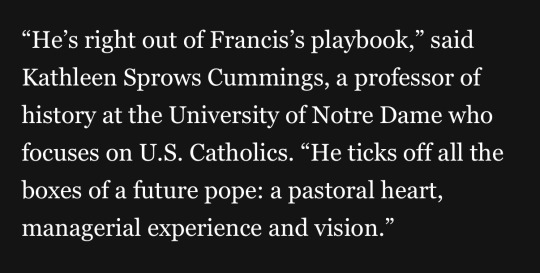
https://www.washingtonpost.com/world/2025/05/08/pope-prevost-american-vatican/
He was even elected by Pope Francis as president of the Pontifical Commission for Latin America and leader of the Dicastery for Bishops, a powerful office at the Vatican that selects bishops around the world.
Pope Francis worked with him often especially on more progressive projects even though Robert Prevost is more moderate
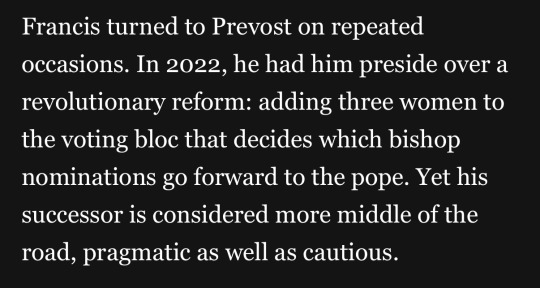
https://www.washingtonpost.com/world/2025/05/08/pope-prevost-american-vatican/
And last thing which is cool in my opinion, he’s a member of the Augustinian Order. The Augustinian Order, also known as the Order of St. Augustine is primarily known for its commitment to community, education, and missionary work, drawing inspiration from the teachings of Saint Augustine of Hippo. They strive to live in harmony, promote unity, and serve the people.
Link
#pope#the pope#conclave#Robert Prevost#pope leo xiv#pope francis#new pope#vatican city#the vatican#Catholic#catholiscism#conclave 2025#vatican#peru#catholic church
607 notes
·
View notes
Text
rich boys don't lose

top!park jongseong x btm!male reader smut
Y/n was still recovering from the blog post. Finals were closing in, and he could barely think. Then Jay started making out in the library like he owned the school—loud, shameless, acting like no one would dare call him out. So Y/n gathered what little courage he had left—and did.
a continuation of ''rich boys don't get dirty.'' continued in "rich boys call it love."
warnings: dubcon, elitism, power dynamics, degrading, spit kink, rough sex, unprotected sex, no prep, drugs use, jay is bi, lowkey inspired by gossip girl

Y/n had nearly forgotten about the blog post—the grainy photo, the caption laced with venom, the slow, cold panic that followed. Not because it didn’t matter, but because something else—someone else—had taken up all the space in his mind.
Park Sunghoon.
The encounters started subtly. A shared glance across the quad. A brush of shoulders in narrow corridors. Then, more frequent. More precise. Always in places Y/n knew by heart—places he visited often, with enough routine to become predictable. And Sunghoon, for all his aloofness, was many things—but never careless.
The south wing reading room. The back alcove of the music building. The third-floor hallway that caught afternoon light just right, turning marble into gold. And—most haunting of all—the bathroom down the south hallway.
The same one.
The same stall.
Nothing ever happened when he showed up. Sunghoon never touched him. Never spoke. Sometimes he didn’t even look. But his presence filled the space like a ghost Y/n couldn’t outrun. He’d catch a glimpse of that posture—impossibly composed, sleeves rolled just so—and every nerve in his body would light up, remembering things he had no business remembering. Things he wasn’t sure he’d survive forgetting.
It wasn’t coincidence. It was calculated choreography. The kind that made avoidance impossible. Which might’ve bothered Y/n—if it didn’t already fascinate him.
Not that he was angry. He couldn’t even bring himself to regret what had happened. There was nothing to regret, not really. Just moments. Heat. Pressure. Teeth. The kind of memory that haunted in the quiet between tasks. And still, with everything on his plate, Sunghoon’s presence was more than just a distraction—it was a complication. One Y/n wasn’t ready to name. Not when his hands were already full with everything else.
St. Augustine’s moved on like it always did—unbothered, untouched. The uniforms stayed crisp, the secrets stayed buried, and Jake Sim remained effortlessly magnetic. He still moved through spaces like he’d designed them himself. Still touched Y/n when no one was looking. Or worse—when everyone was.
A palm resting on his knee beneath the dining hall table. Fingers trailing the inside of his wrist while they waited for class to begin. A casual brush of thigh-to-thigh in the chapel pews, held just long enough to mean something—and just short enough to deny it.
Jake never said anything about it. He didn’t need to. His attention was a performance, and he knew his lines well. But sometimes... sometimes he did more than perform. Sometimes, with just a glance or a tilt of the head, he’d make Sunghoon disappear.
Not in a dramatic way. Not like drama was ever their style. But there were moments—quiet, calculated ones—where Jake would slip beside Y/n and Sunghoon would vanish, almost as if by design. And whether that was intentional or not, Y/n couldn’t say. He didn’t dare ask.
It wasn’t that there was history between them—Jake and Sunghoon. Not that he knew of. But the air always shifted when they were near each other. Not hostile. Just… sharp. Like the static before a storm.
Jake wore charm like a second skin, polished and pristine. Every smile rehearsed. Every movement measured. Meanwhile, Sunghoon didn’t bother. His honesty was brutal, but clean. Cruel, but clear.
And Y/n? He was somewhere in the middle. Still playing both sides of a game he hadn’t agreed to join.
Y/n needed to slow down. Just breathe. Just think. But even that felt like a luxury these days.
The blog had gone quiet—not deleted, not forgotten, just… paused. Like it was holding its breath. And that silence only made things worse. Y/n didn’t know if he was a target waiting for the next blow, or if he’d simply been a pawn in someone else’s mess. Maybe he was nothing but filler content, background noise for a bigger scandal. The not-knowing gnawed at him. He hated being left in the dark. It made him feel smaller than he was.
Everyone else, meanwhile, seemed to shift gears. Slowly. Quietly. Study groups started filling faster. Even the loudest people spoke softer in the afternoons. There was an unspoken urgency hanging in the air—exams looming just ahead, like a storm everyone pretended not to see. Some students buried themselves in textbooks, hoping to impress absentee fathers or cold mothers. Others didn’t bother—they were legacy kids, already set to inherit companies or empires, tests be damned. And then there were the ones who wandered, looking just as lost as they felt.
Y/n wasn’t failing, but he wasn’t exactly trying either. He hovered comfortably in the middle—never top of the class, but never low enough to raise concern. He was sharp, capable, but too emotionally occupied to care about test scores. Studying felt like something people did when they didn’t have heavier things sitting on their chests.
Everyone had their method. Sunghoon was disciplined—quiet, focused, precise. He studied like he did everything else: with clean lines and zero room for error. Jake, on the other hand, studied people. He slipped between conversations like silk, hands always moving, eyes always scanning. He collected names and favors the way others collected grades, and somehow, it worked. Y/n didn’t mind either of them. He made conversation when necessary, nodded in the right places, offered his usual dry one-liners. He existed. And that was enough.
But there was one type of person Y/n couldn’t stand.
The entitled. The performative. The ones who acted like being born rich gave them the right to waste everyone’s time—and then dared to be proud of it.
Jay Park was that person.
In Y/n’s mind, if you wanted to live like a mess, go ahead. Get drunk. Smoke on rooftops. Hook up behind dorms. He didn’t care. But don’t do it during class. Don’t roll your eyes at professors who spent years building their reputations. Don’t lean back in your chair like the room owes you something. Don’t make a mockery of the opportunity so many others would kill for.
Jay did all of that, and more.
Just thinking about him was enough to make Y/n’s jaw clench.
It wasn’t just the eye-rolls in class, or the way he strutted into the room like time bent for him. It was the smirk he wore like it meant something. The lazy posture, the undone tie, the way his blazer always hung off one shoulder like he couldn’t be bothered to dress himself properly. He acted like he was too important to care. Like the world would adjust itself to him eventually.
But it wasn’t just Jay. Not really.
It was the name.
Jay Park, son of that Park—the one who ran an inherited Manhattan firm like it was his birthright. A firm that had been passed down like silverware, polished and untouchable. And of course, rival to Y/n’s father—who had built his empire from nothing. No legacy, no family favors. Just grit, late nights, and deals no one else was brave enough to touch.
Y/n had grown up hearing about the Parks. Hearing his father’s voice harden at the mention of them. “Inherited power is just arrogance with better tailoring.” And he knew—knew—Jay had been fed the same kind of poison from the other side. Their last names were oil and water. Their fathers saw to that.
So no, it wasn’t a coincidence that Y/n hated him.
It wasn’t personal. It was inevitable.
But God, did Jay make it easy. The way he looked at people—like they bored him. Like everything was beneath him. Like Y/n was just another nothing in a long list of things he couldn’t be bothered to care about.
And maybe that’s what made Y/n angriest of all.
Because if Jay was going to be his enemy, the least he could do was try.
But the breaking point came on a Thursday afternoon.
Y/n had only wanted a moment of silence. The second floor of the library was usually reliable—quiet, cold, steady. But when he turned the corner of the philosophy section, what he saw made his stomach twist.
Jay Park. Bent over a table like he owned it. One hand gripping someone’s thigh, the other resting beside a half-read book no one was actually reading. Their mouths were too close. Clothes disheveled. And worse—far worse—was what sat openly beside them: a small, clear bag catching the light through the window. White powder.
Nothing was hidden. Not the act. Not the drugs. Not the laugh in Jay’s throat as he leaned in, utterly unbothered by the quiet chaos of it all. A few tables away, students were hunched over notebooks, trying to survive exam season. Meanwhile, Jay was throwing away the rules like they never applied.
Maybe they didn’t. Maybe they never had.
But seeing him there, smiling like the universe owed him something—it made Y/n burn.
His fingers moved before he could think. Flash off. Angle sharp. One glance to make sure no one was watching. Click. One photo. Enough to tell a story.
And it was perfect.
Y/n stared at the screen for a second too long. The lighting was clean, natural. Jay’s face smug, high on himself and whatever else he’d taken. The bag was in frame. Clear. The composition almost felt intentional.
It reminded him of those once-a-year shots of lightning striking Christ the Redeemer. Clean. Rare. Timed down to the millisecond. The kind of photo that made headlines—respected for being both lucky and ruthless.
This was that. And he’d nailed it.
He didn’t say anything. Didn’t confront anyone. Just walked out, let the image burn into the back of his mind, and didn’t stop until he was home.
It wasn’t until later, alone in his room, that the weight of the day fully landed. The photo still open on his phone. His chest still tight. His jaw locked.
The question wasn’t if he’d send it. It was to who.
For Y/n, finding the number didn’t take long. His father’s old planner sat at the bottom of the home office drawer. Leather-bound. Tidy. Sharp. Full of names that made other people flinch.
Y/n flipped through pages until he found the one he needed. He attached the photo. No message. No context. Just the image.
There were two ways this could go.
Either Jay’s father would ignore it, like his son ignored everything else. Or he’d finally see what everyone else refused to—and fix it.
Y/n set the phone down and stared out the window. The sky didn’t offer clarity. It never did.
But for the first time in weeks, he felt like he’d done something right.
Petty, maybe.
But right.
Y/n decided to take a shower.
Not the quick, functional kind—but the kind that felt like a reset. Steam curling up the walls, the kind of heat that scalded just enough to sting. He stood there longer than usual, letting the water hit the back of his neck like it could knock the weight off his spine. It didn’t. But it helped.
Dinner was already being prepared downstairs. The smell had drifted in while he toweled his hair. Something rich. Subtle. Their personal chef always did that—never asked what anyone wanted, just made what he knew would calm the house down. Tonight, it was roasted duck. Fresh vegetables. A sauce Y/n couldn’t name but finished entirely.
He ate alone in the dining room. Quiet. Slow. He didn’t even look at his phone. For a moment, the world was still—no Sunghoon, no Jake, no blog, no noise. He allowed himself to pretend it would stay that way.
Then his phone buzzed.
Just once. Soft. Dull.
He almost ignored it. But his curiosity always knew how to bite harder than his indifference.
It was a message.
Brief. Polite. Distant.
A thank-you for what he’d sent.
And an address.
He stared at it for a while, blinking slowly, jaw tightening as the meaning landed. It wasn’t just an address. It was that address.
The Park family firm.
Sleek, corporate, laced with generational arrogance. The kind of building that made people walk straighter when they passed it. It wasn’t just a place—it was a statement.
Y/n didn’t reply.
He tossed the phone onto the bed and sat on the edge, elbows on his knees, still tasting the glaze from dinner. He thought about what the message meant. What kind of father responds with an invitation after seeing that?
It was the closest thing to gratitude he’d ever get from someone like that.
Part of him was tempted to ignore it. Pretend he never saw it. Let Jay implode on his own timeline. But the idea of walking into that firm... of sitting across from a man who might actually be willing to hold his son accountable?
That curiosity itched.
And maybe—just maybe—it was the end of something. Or the start of something else entirely.
Still, he wasn’t going with hope. He wasn’t stupid.
He wasn’t expecting peace. Or grace. Or apologies wrapped in ribbon.
But he was expecting to see Jay’s face. The tightness in his jaw. The forced humility in his voice. Y/n wanted to hear the words that had been carefully typed in the message actually spoken. Wanted to see what someone like Jay looked like when cornered.
There was just one problem.
His father could never know.
Setting foot in the Park firm would be a betrayal of the highest order. A sin. His father would rather hear that Y/n had committed a federal crime than hear he’d voluntarily walked into that building. Pride, in this house, ran deeper than blood. And the Park name? That was a red line.
But some sins were worth it.
Some betrayals were too satisfying to resist.
And if it meant watching Jay Park squirm in a chair that was never built for shame? Then Y/n would gladly commit it. Y/n put on something presentable. Neat. Sharp.
He didn’t overthink it—but there was something deliberate in the way he carried himself afterward. Like he was getting ready for something final. The weight of the moment hung on his shoulders, but it didn’t feel heavy. If anything, it felt earned.
By the time he looked in the mirror, a smile had already settled on his face.
Not polite. Not rehearsed.
Wide. Satisfied. Victorious.
Like he had already won, and all that was left was to enjoy the aftermath.
As the elevator carried him down, the silence around him only made it better. He leaned back against the wall, alone with the sound of his own quiet laughter. It bubbled up without warning—light, free, almost absurd. Gratitude, maybe. Or just the thrill of knowing something was finally tipping in his favor.
The city greeted him with its usual noise.
Manhattan didn’t pause for anyone. But tonight, it felt like it was humming just for him.
He stepped out of the building, flagged the first cab he saw, and got in without hesitation.
Gave the address.
Sat back.
Smiling.
He was going. And for the first time in a long time, he felt good about it.
After some minutes, Y/n stepped out of the cab, paid the fare, and left a generous tip. Nothing could ruin this night—not even the fact that he was willingly stepping into that miserable excuse of a firm. He walked through the glass doors like the floor wasn’t even worth touching his shoes. Every step was soaked in disdain. He wanted to yell, right there in the lobby, that they’d all be jobless soon enough—once the firm came crashing down under the weight of the owner's immature son who couldn’t even subtract properly. But he didn’t. Just thinking it was enough.
Life felt too perfect to waste time gloating. He gave his name to the receptionist with a politeness that barely masked his satisfaction. She looked up, nodded once, and motioned toward the elevator. He was cleared to go up.
Of course the office was on the top floor.
Y/n kept the smile on his face the entire way. That smug, unshakable smile that had been sitting comfortably on his lips since dinner. It hadn’t moved. He didn’t expect it to.
Outside the door, he paused. Took a deep breath. Let the calm settle again. Then, he pushed it open.
The office was minimalist. Sleek. Dimly lit by the city bleeding through the tall windows. The chair behind the desk was turned away—facing the skyline. A little dramatic, but whatever. Y/n didn’t think twice.
“Good night, Mr. Park,” he said, still carrying that thread of pride in his voice as he stepped further into the room.
The chair turned.
And Y/n’s stomach dropped.
Jay.
The smile disappeared from his face like a line of coke near Jay—gone before you even realized it was there.
Fuck.
Jay stood up slowly, like he’d been waiting for this exact moment. His grin was all teeth and poison.
“What can I do for you?” he asked, voice sugary, mocking.
Then he reached into his jacket pocket, pulled out a cracked iPhone 6, and tossed it onto the floor between them. The impact echoed.
“God, Y/n… you’re so fucking dumb,” Jay laughed, shaking his head. “Seriously. Full-on airhead.”
He took a step closer, voice rising with amusement. “You sent it to my dad’s old number. You really thought he was gonna care?”
Another laugh. Cruel this time.
“Do you honestly believe he gives a shit if I’m eating pussy instead of a cafeteria sandwich? You think he gives a single fuck what I do? Come on.”
Y/n didn’t move. Didn’t speak. He just stood there, realization crawling over his skin like frostbite.
And Jay?
Jay looked like he was enjoying every goddamn second of it.
Y/n didn’t move. Didn’t speak.
He just stared, jaw tight, the inside of his cheek aching from how hard he was biting down. His hands curled slowly into fists at his sides—not to swing, but to stay still. To stay collected. Jay wanted a reaction. He could feel it in the smugness laced through every word, every slow step closer.
Y/n wasn’t going to give it to him. Not that easily.
Jay tilted his head, watching him. Studying. Like Y/n was some strange, fragile thing on display—seconds away from cracking.
“You’re quiet now,” he murmured. “Where’s that smug little smile from earlier, huh? The one you wore in the elevator like you were walking into some kind of coronation.” He tilted his head, grin spreading slowly. ”You really thought I wasn’t watching? I saw you the second you stepped out of the elevator. Security cameras, Idiot. You walked in like you owned the place."
Y/n exhaled slowly, trying to keep the heat in his chest from spilling into his face. “You’re a piece of shit,” he said, voice low, controlled.
Jay’s lips curved, just slightly. “And yet… here you are.”
He took another step, slow and easy, the way someone does when they know you won’t stop them.
Y/n’s breath hitched—not because he was afraid. But because the space between them had thinned to something dangerous. Something charged. Something stupid.
“Tell me,” Jay said, voice dipping lower, “what exactly were you hoping to see tonight? Hm? My dad? A lecture? Maybe even some forced apology while I stood in the corner like a scolded prince?”
Y/n didn’t answer. He didn’t need to.
Jay was already closing the distance.
His tone dropped again—just enough to hum against Y/n’s skin. “Or maybe… you wanted to see me ruined. Humbled. Humiliated. Is that it?”
Y/n met his eyes, unblinking. “You deserve worse.”
Jay smiled again, but this one was different. Slower. Hungrier. “Yeah? And yet, I’m the one who has you standing here… red-faced… breath all shaky. Tell me, Y/n—are you mad?”
Y/n’s eyes narrowed, but his body betrayed him. That flicker of heat. That sharp, gut-punch pulse that came with proximity and resentment and something else he didn’t want to name.
Jay stepped even closer, close enough that Y/n could smell his cologne—something clean, expensive, and utterly infuriating.
“You wanna hate me so bad,” he whispered, leaning just slightly forward. “But you’re still here.”
Y/n opened his mouth—to say something, to insult him, to regain control—but the words never came.
Because in one sudden, precise motion—Jay spat in his face.
The air snapped between them.
Y/n flinched, barely—but it was enough.
The spit clung to his cheek, warm and humiliating. His breath caught. Every muscle in his body went still, buzzing with shock and fury and something far, far more dangerous underneath.
Jay didn’t flinch. Didn’t move back. Just tilted his head, gaze fixed on Y/n’s face like he was watching art unfold.
Then, calmly—almost softly, he asked:
“Does that turn you on?”
Y/n’s chest heaved with the inhale he tried to bury. His jaw clenched tighter, lips twitching with a dozen unsaid things.
He wanted to hit him.
He wanted to walk out.
He wanted to fucking stay.
Jay smirked.
“Bet it does.”
Y/n’s fists stayed clenched at his sides, but his body was doing something he couldn’t control—something traitorous.
He felt it too late. That slow, aching heat settling low in his stomach, crawling under his skin and down. It was the humiliation, the power play, the way Jay’s voice wrapped around his neck like a ribbon pulled tight. His mind screamed at him to move, to react, to do something—but his body had already responded.
Jay noticed. Of course he did.
His gaze dropped, deliberately slow. Lingering. And when his eyes found what he was looking for, his smile stretched wider—lazy and victorious. He dragged his teeth across his bottom lip, not even pretending to hide the thrill of it.
“Well, well,” Jay murmured, tone syrupy with mock affection. “Looks like you really are enjoying yourself.”
Y/n said nothing, but the flush in his cheeks deepened, throat burning as he tried to shift—subtle, defensive—but it was too late. The outline in his pants was obvious now. Clear. And Jay had already seen it.
“God,” Jay breathed, almost laughing. “Is that why you sent the picture?”
He stepped forward again, toe to toe now, voice dropping into a low, dangerous hum. “Was it jealousy?”
Y/n’s jaw clenched so tightly it ached.
“You saw me with her,” Jay continued, dragging out each word like it tasted sweet on his tongue. “Bent over the table. My mouth on her neck. My hands under her skirt. And what—suddenly you wanted to be the one moaning for me in the middle of the library?”
Y/n flinched, but he didn’t move away.
Jay leaned in, his breath ghosting over Y/n’s ear. “Did you imagine it was you?”
And then—his hand moved.
Smooth. Confident. Jay slid his palm over Y/n’s bulge, cupping him through the fabric with slow, deliberate pressure. His fingers curved slightly, like he was testing weight, testing control. Y/n’s entire body jolted—shoulders stiff, breath caught.
The contact was hot. Wrong. And it made Y/n burn.
Jay pulled back just enough to meet his eyes again—dark, gleaming, cruel. “Did you jerk off to the photo before you sent it?”
Y/n still didn’t answer. He couldn’t. His hands twitched at his sides. His chest rose sharply, but the heat in his pants pulsed harder beneath Jay’s grip—shameful and alive.
Jay smiled wider. “Yeah,” he whispered. “That’s what I thought.”
Jay’s hand didn’t move at first—still pressed firm against Y/n’s cock, like he was weighing it, owning it. Then his gaze dragged down, slow and hot, eyes burning a path over Y/n’s body.
“You know,” he muttered, voice low and thick, “for someone who pretends to be so fucking composed… you’ve got the filthiest body I’ve ever seen.”
Y/n flinched, breath catching in his throat.
Jay smiled. “Bet you don’t even know what you look like right now. All flushed and hard, like you’re seconds from begging. Like you want me to bend you over this desk and ruin you.”
His voice dropped further, curling dark around the edges. “Would you cry if I fucked you here, hm? Would that pretty little mouth still talk back if I had you moaning into the wood?”
Y/n’s fists clenched tighter—but he couldn’t deny the pulse between his legs. He hated how right Jay was. How everything in his body screamed to move, to fight, to stay.
Jay’s hand moved suddenly—down, lower, grabbing Y/n’s ass with both hands, squeezing hard. Fingers digging in like he owned it, thumbs pressing deep into muscle.
“Fuck,” he breathed, half to himself. “This ass? No wonder you walk around like a tease. You’ve probably got no idea how fuckable you are.”
Y/n gasped, hips jerking forward involuntarily. It wasn’t a moan, not really—but it wasn’t denial either.
Jay leaned forward, lips brushing the shell of his ear. “You wanna be mad at me so bad, but your body keeps fucking whining for it.”
That was it. Y/n shoved him. Hard.
Jay stumbled back a step, laughing—low and breathless, eyes shining like he’d just won a game no one else knew they were playing.
Y/n’s chest lifted and fell, fists shaking, skin burning where Jay had touched him. His cock strained hard against his pants, leaking, aching.
“Stay the fuck away from me,” he snapped—finally, voice rough, cracked open.
Jay grinned. “Oh, now you’ve got a voice?”
He licked his lips, eyes dark and hungry. “Good. You’re gonna need it when I make you scream.”
Jay moved with the cold confidence of someone who already owned Y/n —each step slow, deliberate, like he was circling something he'd already caught.
Y/n barely had time to react before Jay’s hands were on him again, gripping the front of his shirt and slamming him back against the office wall. The impact knocked the air from his lungs, his head thudding against the sleek surface. Jay’s body pressed flush against his, all hard muscle and searing heat, pinning him in place.
“You don’t get to push me away,” Jay growled, voice rough with something feral. “Not after this.”
His knee slid between Y/n’s thighs, forcing them apart, and Y/n’s breath hitched as the pressure sent a jolt of pleasure straight to his cock. He bit down on his lip, refusing to give Jay the satisfaction of hearing him break.
But Jay wasn’t having it.
One hand fisted in Y/n’s hair, yanking his head back, exposing his throat. Jay’s mouth crashed against his skin—not a kiss, not even close. Teeth scraped over his pulse point before biting down, hard enough to bruise. Y/n gasped, hips jerking forward, his body betraying him all over again.
“Fuck—!”
Jay pulled back just enough to smirk at him, lips glistening. “That’s it,” he murmured, voice dripping with dark amusement. “Let me hear how much you hate it.”
His free hand slid down Y/n’s chest, fingers skimming over the outline of his cock through his pants, teasing. Y/n’s breath came in sharp bursts, his body trembling with the effort to stay still, to not fucking grind into Jay’s touch like some desperate slut.
But Jay knew. Of course he did.
“You’re so fucking pathetic,” Jay breathed against his ear, fingers finally undoing Y/n’s belt with practiced ease. “Sending that picture like you had some kind of power over me. Like you could ruin me.”
His hand slipped past fabric, wrapping around Y/n’s cock in one smooth motion.
Y/n choked on a moan, his hips bucking forward on instinct.
Jay’s grip tightened, thumb swiping over the leaking tip, spreading the wetness in slow, torturous circles. “Look at you,” he taunted. “Already dripping this much. You really thought you could hide how desperate you are?”
Y/n’s nails dug into his own palms, his entire body coiled tight, torn between shoving Jay off and begging for more.
Then his hand moved—fast, ruthless—stroking Y/n with a punishing grip, twisting just right on the upstroke, thumb pressing into the slit with every pass.
Y/n’s knees nearly gave out. A broken sound tore from his throat, his head falling back against the wall.
Jay watched him unravel with a smirk, his own breathing ragged, his own need obvious in the way his hips pressed forward, grinding against Y/n’s thigh. “That’s it,” Jay murmured, voice rough. “Dripping for someone you swore you’d never touch.”
Y/n’s vision blurred. His body burned. And then—Jay stopped. Just like that. His hand withdrew, leaving him throbbing, desperate, cock twitching in the cold air. His eyes flew open, meeting Jay’s darkened gaze. Jay licked his lips, slow, deliberate. “Beg,” he said. His chest heaved. The smirk turned vicious. “Or do I have to make you?”
Y/n swallowed hard, pride warring with the fire in his veins. In one brutal motion, Jay spun him around, shoving him face-first against the wall. A hand pressed between his shoulder blades, keeping him pinned as the other yanked his pants down just enough. His breath came in ragged bursts. Jay leaned in, lips grazing his ear.
“This,” he murmured, voice dripping with venom, “is what you wanted, isn’t it?” Then he spat into his palm.
Y/n barely had time to process before Jay’s fingers pressed against him—dry, rough, unforgiving. He tensed, a sharp gasp escaping him. Jay laughed, low and dark. “Too late to back out now.”
And then—
He pushed in.
Y/n’s entire body jerked, his fingers scrambling against the wall. It burned, it ached, it fucking tore—and yet, his cock throbbed, leaking against the cold glass behind him.
Jay didn’t give him time to adjust. His fingers curled, scissoring, stretching, relentless.
“Fuck—Jay—!”
Jay’s breath was hot against his neck. “Say it again.”
Y/n’s nails dug into the wall.
Jay’s free hand gripped his hip, fingers pressing hard enough to bruise. “Say my fucking name.”
Y/n’s body shook.
Jay added a third finger.
A ragged moan ripped from Y/n’s throat.
Jay’s teeth grazed his shoulder. “Good boy.”
Then his fingers were gone. Y/n barely had time to breathe before Jay’s cock pressed against him—hot, heavy, relentless. Jay didn’t ask. He didn’t wait. He shoved in—hard. Y/n’s mind blanked, vision flickering with stars. A broken cry tore from his lips as Jay buried himself to the hilt in one brutal thrust. Jay groaned above him, his grip tightening on Y/n’s hips. “Fuck,” he hissed. “Tighter than I fucking thought.”
Y/n panted, his body stretched to the limit, every nerve alight with pain and pleasure and something dangerously close to need.
Jay didn’t give him mercy
He pulled back—only to slam in again.
And again.
And again.
Each thrust was punishing, each snap of his hips driving Y/n further into the wall, further into the haze of pleasure-pain.
“This—” Jay growled, fingers digging into Y/n’s skin, “—is what you get.”
Another thrust, harder.
“You don’t—”
Another.
“Fuck with me—”
Another.
“And walk away.”
Y/n’s body burned. His cock ached, untouched, leaking against the glass. Every drag of Jay inside him sent sparks up his spine, his toes curling, his breath coming in ragged, punched-out gasps. Jay’s pace was relentless, his grip bruising, his breath hot against Y/n’s neck. “You feel that?” he panted, voice wrecked. “That’s what you fucking did to me.” Y/n couldn’t speak. Couldn’t think. All he could do was take it.
Jay’s hand slid around his waist, fingers wrapping around Y/n’s cock at last.
Y/n sobbed.
Jay stroked him in time with his thrusts, rough, perfect, maddening.
“Come for me,” Jay demanded, voice raw. “Come on my cock like the fucking slut you are.”
Y/n’s body obeyed with no denial.
His orgasm ripped through him like a live wire, his back arching, his vision going white as he spilled over Jay’s fingers with a broken cry.
Jay fucked him through it, his thrusts turning heavier and rougher., his grip bruising.
Then—with a low groan—he buried himself deep and came, his hips stuttering against Y/n’s ass.
For a moment, the only sound was their ragged breathing.
Then Jay pulled out.
Y/n’s legs gave out. He barely caught himself against the wall, his body trembling, his mind hazy.
Jay stepped back, adjusting his clothes with a smirk.
“Now we’re even.”
And with that, he turned and walked out—leaving Y/n wrecked, used, and utterly fucking ruined.

note: hey everyone! just sliding in here at the end to check on you — did we survive this chapter? barely? love that for us hehe. thank you so much for all the love, seriously. i wasn’t expecting any of it when i first started posting, and now here we are at the second-to-last chapter… kinda wild. you’ve made writing this such a fun ride, and i’m really excited (and a bit nervous) for you to see how it all ends. finale soon — rest up, hydrate, and maybe emotionally prepare a little. see you there :)
#park jongseong x male reader#jongseong x male reader#jongseong x reader#jongseong smut#enhypen x reader#enhypen x male reader#enhypen smut#kpop x male reader#kpop x male reader smut kpop x reader#kpop smut#x male reader#x male reader smut#jongseong x yn#smut#jay x male reader#jay park x male reader#jay x reader#jay smut#jay x yn#luke fics :)
446 notes
·
View notes
Text
Leftist antisemitism is a symptom - American Jews and the Illiberal Left
TLDR: I think we would be wise to stop regarding leftist antisemitism only in its own context and habitually recognize it is a part of a larger issue, the rise of the illiberal left.
Why are Jews are the most reliable supporters of Liberal policies and politicians in modern American history?
Haviv Rettig Gur seems to suggest that Jews in the US, recognizing that Liberal values resulted in their (imperfect but historic) emancipation in the US, became perhaps the most Liberal people ever. They understood that US Liberal values were what made Jews relatively safe in the US, and offered them opportunities which had been denied to them everywhere else.
When previously did a head of state speak to Jews the way George Washington did?
Gur suggests that this is why American Jews have historically been so invested in the struggle of black folks in the US. When I say invested, I'm talking about facts like these:
- Henry Moscowitz was one of the founders of the NAACP.
- Kivie Kaplan, a vice-chairman of the Union of American Hebrew Congregations (now called the Union for Reform Judaism), served as the national president of the NAACP from 1966 to 1975.
- From 1910 to 1940, more than 2,000 primary and secondary schools and 20 Black colleges (including Howard, Dillard and Fisk universities) were established in whole or in part by contributions from Jewish philanthropist Julius Rosenwald. At the height of the so-called "Rosenwald schools," nearly 40 percent of Black people in the south were educated at one of these institutions.
- Jews made up half of the young people who participated in the Mississippi Freedom Summer of 1964.
- Leaders of the Reform Movement were arrested with Rev. Dr. Martin Luther King, Jr. in St. Augustine, Florida in 1964 after a challenge to racial segregation in public accommodations.
- Rabbi Abraham Joshua Heschel marched arm-in-arm with Dr. King in his 1965 March on Selma.
- The Civil Rights Act of 1964 and the Voting Rights Act of 1965 were drafted in the conference room of Religious Action Center of Reform Judaism, under the aegis of the Leadership Conference, which for decades was located in the RAC's building.
When I was a child and asked my mother why Jews seemed overwhelmingly to be Democrats, I was told "because of FDR and the Civil Rights movement." That's not wrong, in Gur's framing, but perhaps a more shallow response than the question deserves.
In Gur's framing, US Jews realized that the promises of Liberalism, over and over, no matter how much they delivered for other peoples, did not deliver for black Americans.
Gur suggests that US Jews worked to see that change for their black co-citizens because if American Liberalism didn't deliver for black Americans what it appeared to promise to all Americans, the sense of safety, security, and belonging which Jews felt in the US was an illusion.
US Jews believed that we had common cause with non-Jewish American Liberals. We thought non-Jewish liberals believed what we believed about universal civil rights, pluralism, enlightenment values and enlightenment reason. When Jews saw the "In this House We Believe" signs on our neighbors' lawns, We felt comforted because those beliefs are also our beliefs.

We thought, for instance, that our non-Jewish friends agreed that Liberal democracies were better for human rights than any form of government in the history of human societies. We thought they agreed that religious, racial, and ethnic intolerance were social ills which needed to be fought with information. We thought they valued data, reason, and reliable sources.
Since 10/7/23, we've been learning that we were mistaken. We've seen gentiles who we thought shared our values seem to discard those values.
We saw college educated friends share antisemitic (and alarmingly familiar) conspiracy theories about Israeli puppetry of US politics and the return of Nazi and Soviet antisemitic slogans/images.
We've seen highly educated "Liberals" preach ahistoric nonsense denying that the Jewish people are from the Levant and willfully ignoring the huge swaths of historical fact which don't support their favored narrative.
We've seen friends rage against "globalists" and "Zionists," when what they mean is 'Jews'.
We've seen people who we thought were allies against all forms of racism justify their racism towards Jews as righteous through specious reasoning like 'I don't hate Jews, just the 97% of Jews who believe that Jews should have self-determination in their homeland.'
We've been told that we cannot ask them to temper their use of antisemitic tropes, because doing so "weaponizes" concerns about antisemitism to obstruct them from their righteous crusade against the most evil nation on earth...which happens to be the only Jewish nation.
Despite this, about 80% of Jewish voters voted for Harris over Trump.
I think US Jews will continue to be Liberals, because Liberal values are dear to us and aligned with our values as Jews, as a historically oppressed minority, and as Americans who see more clearly than some others the gap between the promise of American liberalism and its long-delayed universal delivery.
The problem, I think, is in how many of our former friends simply aren't Liberals any longer.
I think Jews in the US need to spend a good deal more time scrutinizing the illiberal left.
Nine days after the attacks of 10/7/23, Jonathan Chait wrote:
Writers like Michelle Goldberg, Julia Ioffe, and my colleague Eric Levitz, all of whom rank among the writers I most admire, have written anguished columns about the alienation of Jewish progressives from the far left. I think all their points are totally correct. But I find the frame of their response too narrow. They are treating apologias for Hamas as a factually or logically flawed application of left-wing ideals. I believe, to the contrary, that Hamas defenders are applying their own principles correctly. The problem is the principles themselves.
...
Liberals believe political rights are universal. Basic principles like democracy, free speech, and human rights apply equally to all people, without regard to the content of their political values. (This of course very much includes Palestinians, who deserve the same rights as Jews or any other people, and whose humanity is habitually ignored by Israeli conservatives and their American allies.) A liberal would abhor the use of political violence or repression, however evil the targets.
...
The illiberal left believes treating everybody equally, when the power is so unequal, merely serves to maintain existing structures of power. It follows from their critique that the legitimacy of a tactic can only be assessed with reference to whether it is being used by the oppressor or the oppressed. Is it okay for, say, a mob of protesters to shout down a lecture? Liberals would say no. Illiberal leftists would need to know who was the speaker and who was the mob before they could answer.
...
One observation I’ve shared with many analysts well to my left is that the debate over this illiberalism and the social norms it has spawned — demands for deference in the name of allyship, describing opposing ideas as a form of harm, and so on — has tracked an older debate within the left over communism. Communism provided real-world evidence of how an ideology that denies political rights to anybody deemed to be the oppressor laid the theoretical groundwork for repression and murder.
There have been conscious echoes of this old divide in the current dispute over Hamas. The left-wing historian Gabriel Winant has a column in Dissent urging progressives not to mourn dead Israeli civilians because that sentiment will be used to advance the Zionist project. Winant sounds eerily like an old communist fellow traveler explaining that the murders of the kulaks or the Hungarian nationalists are the necessary price of defending the revolution. “The impulse, repeatedly called ‘humane’ over the past week, to find peace by acknowledging equally the losses on all sides rests on a fantasy that mourning can be depoliticized,” he argues, calling such soft-minded sentiment “a new Red Scare.” Making the perfect omelette always requires some broken eggs in the form of innocent people who made the historical error of belonging to, or perhaps being born into, an enemy class.
But more than three decades have passed since the Soviet Union existed or China’s government was recognizably Marxist. And so the liberal warning about the threat of left-wing illiberalism seemed abstract and bloodless. On October 7, it suddenly became bloody and concrete. It didn’t happen here, of course. The shock of it was that many leftists revealed just how far they would be willing to follow their principles. “People have repeated over and over again over the last few days that you ‘cannot tell Palestinians how to resist,’” notes (without contradicting the sentiment) Arielle Angel, editor-in-chief of the left-wing Jewish Currents. Concepts like this, treating the self-appointed representative of any oppressed group as beyond criticism, are banal on the left. Yet for some progressive Jews, it is shocking to see it extended to the slaughter of babies, even though that is its logical endpoint. The radical rhetoric of decolonization, with its glaring absence of any limiting principles, was not just a rhetorical cover to bully some hapless school administrator into changing the curriculum. Phrases like “by any means necessary” were not just figures of speech. Any means included any means, very much including murder.
Both Julia Ioffe and Eric Levitz have pointed out that decolonization logic ignores the fact that half of Israel’s Jewish population does not have European origins and came to Israel after suffering the same ethnic cleansing as the Palestinians. This is correct. But what if it weren’t? If every Israeli Jew descended from Ashkenazi stock, would it be okay to shoot their babies?
The problem is much greater than leftist antisemitism. The illiberal left has become nearly as great a threat to Liberalism as the far right.
It is often the case that a movement’s treatment of Jews serves as a broader indicator of its health. It’s not an accident that the Republican Party has become more attractive to antisemites as it has grown more paranoid and authoritarian. What the far left revealed about its disposition toward Jews is not just a warning for the Jews but a warning for all progressives who care about democracy and humanity. The pro-Hamas left is not merely indicating an indifference toward Jews. It is revealing the illiberal left’s inherent cruelty, repression, and inhumanity.
I'm annoyed that it is has taken me so long to catch on and alarmed by the implications.
I am, however, very proud of my 14yo, who sums up her experience trying to respectfully disagree with leftists this way:
"They're allergic to nuance."
#civil rights movement#liberalism#US History#jewish history#jewish american history#american jews#Jumblr#african americans#Black Americans#Illiberal left#far left#leftist antisemitism#leftist antizionism
597 notes
·
View notes
Text
Just Kiss Me (WIP)
DEMO - FORUM PAGE
Hello everyone! After recommendation from some people on the forum, I have finally gotten around to making a Tumblr page for my WIP, Just Kiss Me. I'm Lucky42, or Lucky, and appreciate you taking the time to read about my WIP.
*Scroll down to bottom for current updates*
Synopsis:
Your senior year kicks off with your family moving from Sacramento, California to Sherfield, a small town in sleepy South Carolina. You are able to get a scholarship to St. Augustine, an elite private school for the wealthy locals. You feel like a fish out of water compared to your coddled peers, but it's only one year, so it can't be that bad. That is, until you accidentally share a smooch with the richest kid in school, which somehow lands you on a supernatural investigation team dedicated to solving the mysteries of St. Augustine. Well, senior year is supposed to be the best one yet, right?
Features:
A choice system that focuses on developing the protagonist's personality
The ability to romance your peers in three ways: Denial, Flirty, or Shy
Three potential scholarship choices (academics, art, sports) all with their own exclusive scenes and characters
The ability to swap bodies with a literal heathen
Morality choices that flesh out how your character sees the world
The ability to influence your peers by leveraging your strongest traits
A banging cafeteria
Characters:
Alistair/Audrey Sawyer (RO):
Who: the rich, preppy kid you have the misfortune of accidentally smooching. This one mistake leaves the two of you intertwined, for better or for worse. And it’s looking like for worse.
Character post: Alistair/Audrey Sawyer
Klaus/Kristina Berg (RO):
Who: a friendly, cheerful student who is eager to please others and is always willing to lend a helping hand. He/she can often be found reading a nauseatingly cheesy romance book.
Character post: Klaus/Kristina Berg
Evan/Ebony Jefferson (RO):
Who: the insanely attractive student council president who has a reputation of being a bit of a heart-breaker. Prides his/herself on knowing every student who walks through the school’s doors. He/she seems to have taken an interest in you.
Character post: Evan/Ebony Jefferson
Darcy:
Who: a whimsical girl with a keen interest in the supernatural and a killer part-time job. Her “research” is the reason you’re a part of this mess. Thus, she’s the de facto leader of your group.
Year: Senior
Appearance: short and slim with brown hair and brown eyes. Speaks with a Southern drawl, thick compared to the rest of your classmates.
Reba: she’s crazy. But you’ll figure that out soon enough.
Progress:
03/23/2025 - 290,000 words (excluding command lines)
Prologue - Finished
Chapter 1 - Finished
Chapter 2 - Finished
Demo word count: 290k
Let me know all of your thoughts and opinions, and thanks a bunch for your time!
#cog#wip#current wip#if game#choicescript#choices#hosted games#cyoa#cyoa game#if wip#dashingdon#romance#supernatural#high school#private school#interactive fiction#interactive novel#just kiss me
450 notes
·
View notes
Text

TRAVEL TIME IN BLACK SAILS
BLUE : direct route Charles Town - Nassau
RED : route taken by Flint after having been blown east by the winds
On the way back from Charles Town (XVIII.), Flint explains to Silver that they are south of Inagua - having made a stop at Tortuga -, still on their way to Nassau because the "winds blew us east. "
THE WALRUS’S SPEED
the Walrus top speed is 7.5 knots. That speed was reached while chasing the Andromache (V.) by risking the masts’s integrity (argument between FLINT and DE GROOT, the t'gallants should not have been unfolded in that wind). With a proper carrening, that speed could be reached safely (“A clean hull means an extra knot or two in speed” in IV.), but the carreening was not completed (in IV: “A few more days, we’ll have the keel cleared and tarred and she’ll be ready to go back into the water”, but the very next day they were chasing the Andromache, as established by SILVER mentionning Randall’s amputation being the previous day).
the Walrus chasing speed is 6 knots, in favorable winds (the speed reched before risking the masts’s integrity, see above).
the Walrus average cruising speed is 5 knots (my estimate, somewhat arbitrary : I take into account the occasional slow wind and a lighter workload on deck to allow shifts for the men to rest).
Average travel time, at 5 knots :
1 knot = 1 nautical mile / h
5 knots = 5 nautical miles / h = 120 nautical miles / 24h
Nassau - Port Royal : 754 nautical miles 754 / 120 = 6,2 ; 6 days at 5 knots
Nassau - Tortuga : 539 nautical miles 539 / 120 = 4,5 ; 4,5 days at 5 knots
Nassau - Havana : 407 nautical miles 407 / 120 = 3,4 ; 3,4 days at 5 knots
Nassau - St Augustine : 511 nautical miles 511 / 120 = 4,2 ; 4 days at 5 knots
Nassau - Charles Town : 631 nautical miles 631 / 120 = 5,2 ; 5 days at 5 knots
Nassau - Savannah : 623 nautical miles 623 / 120 = 5,2 ; 5 days at 5 knots
Nassau - Boston : 1426 nautical miles 1426 / 120 = 11,8 ; 12 days at 5 knots
*The farther away, the most likely it is to wait days for the wind, or be blown off course (see map above).
#black sails#bs refs#black sails fic#gorgiawrite#timeline#they have this thing where skiffs are really fucking fast#so I'm putting those at 10 knots which is more realistic#the Walrus speed is entirely based on Black Sails#in reality 5 knots is a low average for a frigate like that
43 notes
·
View notes
Photo

J. R. Giddings' Account of the Dade Massacre of the Second Seminole War
The Dade Massacre (also given as the Dade Battle, 28 December 1835) was the opening engagement of the Second Seminole War (1835-1842) between Euro-American forces and those of the Seminole, Black Seminole, and runaway slaves who had found freedom among the Native Americans of Florida. Of the 110 men of Dade's command, 108 were killed.
Dade Massacre Site Illustration
Unknown Artist (Public Domain)
Major Francis L. Dade (l. 1792-1835) was ordered by General Duncan Lamont Clinch (l. 1787-1849) to march his men from Fort Brooke to reinforce the garrison at Fort King and chose a slave named Louis Pacheco, owned by one Antonio Pacheco of a nearby plantation, as his guide. Louis, who secretly had close ties to the Exiles (runaway slaves from the Carolinas, Georgia, and other slave-holding states), Black Seminoles, and Seminoles, alerted them to the route Dade would take to Fort King and suggested the perfect place for an ambush.
Louis' plan worked as envisioned and almost the entire command, including Dade, was killed in the attack. The casualties for the Seminole alliance were three killed and five wounded. The Dade Massacre and the ensuing Second Seminole War were a direct result of the Indian Removal Act of 1830 and the common practice of slave-hunters from the United States kidnapping former slaves, Black Seminoles, and freedmen for enslavement on US plantations.
There was no formal victory declared at the end of the Second Seminole War, and no treaties were signed. Many of the Seminole, Black Seminole, and former slaves were able to negotiate relocation to Indian Territory (modern-day Oklahoma), while others were forcibly removed, and still others never surrendered and remained in Florida.
One of the most detailed accounts of the Dade Massacre comes from the famous abolitionist Joshua Reed Giddings (l. 1795-1864) of the US House of Representatives in his book The Exiles of Florida: or, The Crimes Committed by Our Government against the Maroons, who Fled from South Carolina and other Slave States, Seeking Protection under Spanish Laws, published in 1858. Giddings' account is based on an earlier history of Florida, which drew on interviews with members of the Seminole forces that ambushed Dade in December 1835.
Joshua Reed Giddings
Matthew Brady (Public Domain)
Spanish Florida, Tensions, & Second Seminole War
The region that became Florida was claimed by the Spanish after Juan Ponce de León landed there in April 1513. Between 1539 and 1559, Spanish settlements developed, displacing the indigenous peoples who included the Creek and the Pensacola nations, but trade was established, and Spaniards married Native Americans of various nations, and, in time, also former slaves who had escaped from bondage in the Thirteen Colonies.
In 1738, Fort Mose, near St. Augustine, was established and garrisoned by escaped slaves who were granted freedom and citizenship in exchange for their defense of the region against encroachments by the British colonists to the north. Fort Mose became the first legally recognized free Black settlement in North America.
Spain encouraged slaves in the Thirteen Colonies to flee to Florida, and many did so, along with an influx of Chickasaw, Choctaw, Muscogee Creek, and Yamasee citizens, some of whom broke off from the larger Creek bands to settle on their own, and these became known as the Seminole, whose name may be derived from the Creek for "runaway" or "outcast." Some Seminole intermarried with former slaves and established their own communities of Black Seminoles. These various groups lived and traded with each other until Spain lost Florida to the British in 1763 after the French and Indian War (1754-1763). The British then established themselves in the region and encouraged their citizens to settle there.
A Seminole Woman
George Catlin (Public Domain)
The Seminole sided with the British during the American Revolutionary War (1775-1783) and, afterwards, Spain was able to retake Florida, and it became a haven for runaway slaves and Native Americans fleeing Euro-American persecution. General Andrew Jackson led troops into Florida to break up these enclaves of African Americans and Native Americans in the First Seminole War (1816-1819). After Jackson became President of the United States, he issued the Indian Removal Act of 1830 to forcibly relocate the Seminole (as well as many other Native peoples of North America) to Indian Territory west of the Mississippi River. Pressure on the Seminole to comply with this led to the Second Seminole War, which also encouraged one of the largest slave uprisings in US history as the Seminole resistance inspired slaves on plantations in the Carolinas and Georgia to fire the fields and flee to Florida.
The event that set the Second Seminole War in motion (though not the cause of the conflict) was the Dade Massacre of 1835. To the Seminole, Black Seminole, and free Blacks of Florida, the Dade Massacre was a great victory, and leaders like Chief Osceola of the Seminole (l. 1804-1838) and John Horse of the Black Seminole (also known as Jean Caballao, l. c. 1812-1882) looked forward to many more. To the US authorities, however, the Dade Massacre was simply proof that the Native Americans had to be removed from Florida along with any of their allies. Osceola died in captivity in 1838, but John Horse was able to lead his people to Oklahoma and then, when US authorities refused to honor their agreement, on to Mexico.
Major Francis Dade's Death
Jesse Olney (Public Domain)
Continue reading...
30 notes
·
View notes
Text


White smoke, new pope.
Just from talking to regular, not terminally online (or online at all) Catholics, the consensus is: eh, could be worse...could be better though.
Which is fair. Since, Christ in toast, you'd think the Church would pick someone with cleaner hands re abuse-crackdown or lack thereof. The Conclave's ability to just hand-wave away truths they don't want to see continues to astound me. Like, he's not Benny16 or JP2, thankfully, but he's definitely not ya boy Frankie.
From Rebecca Solnit:
What the new pope was up to earlier this year: Vance and Trump smackdown. All hail Leo XIV, who though a US guy served in Peru, and may he be as good on climate as Francis. Washington Post: "The “Latin Yankee,” as he is known in Rome, worked 20 years in Peru’s poorest enclave — falling so in love with the country that he became a naturalized citizen. His commitment there echoes the legacy of Pope Francis, an Argentine who became the Catholic Church’s first leader from South America."
Okay but this seems more serious, though I'd suspect every powerful priest of his generation is guilty of this: "We can be a missionary church, a church that builds bridges, that is always open to receive everyone — just like in this square, to welcome everyone, in charity, dialogue and love,” he told the huge crowd assembled before him. He also issued a greeting in Spanish and a shout-out to his former diocese in Chiclayo, Peru.
In picking the 69-year-old Prevost, the papal conclave looked past allegations that he had mishandled or failed to act on sexual abuse cases involving priests in both Peru and the United States.
He was selected despite being “an enigma to cardinals, especially to American cardinals, because he spent his life outside of the United States,” said Jon Morris, a theologian and former priest who has been in Rome to observe the transition as a Fox News contributor.
Prevost, who is fluent in English, Spanish, Portuguese, Italian and French, was twice elected top leader of the centuries-old Order of St. Augustine. Its website describes the international order as “living together in harmony, being of one mind and one heart on the way to God,” calling nothing your own and living communally.
#rebecca solnit#pope leo xiv#catholic#Catholicism#cathblr#popes#pope bob#chicago pope#meanwhile in rome#augustinian order#not the worst choice but not the best#jd vance killed the pope#ordo amoris
23 notes
·
View notes
Note
dear mads, after reading the entirety of your rust fics I have to ask, how did you cultivate your writing style? The way you write has completely enamoured me. If you have any recommendations for books that have inspired you, or any resources that you think are useful for an aspiring writer and student please share! 🩷🩷
thank you so much, and of course!
I’ve been writing for well over a decade now but I enjoy being an amateur, if I took it too seriously I wouldn’t enjoy it, which is why I don’t draw or paint anymore. So, I don’t abide by most grammar rules and I can’t diagram a sentence, if you asked me to point to a preposition right now, I’d probably cry, but I love playing with language. Keep reading, enjoy the process, challenge yourself to a genre you avoid (for me that’s Lee Pace or Tom Clancy), I find that shopping for books in person is great for finding things I typically wouldn’t buy— but I live in the middle of no where and my one book store folded 8 years ago so it’s like a Genuine Treat to go book shopping. Stage plays can be really quick to read, I keep one in the back of my writing notebook— The Vandal by Hamish Linklater, but I do have a copy of Killer Joe by Tracy Letts if that was anyone’s first guess. I read a lot of non fiction, mainly north american history.
Favorite books that I see in my bedroom as I avoid two finals in no particular order/genre— Mongrels by SGJ, The Bone Season, Barkskins by Annie Proulx, An Indigenous People’s History of the United States by Roxanne Dunbar-Ortiz, Stony the Road by Henry Louis Gates Jr, Their Eyes Were Watching God + Dust Tracks on a Road by Zara Neale Hurston, Latitude by Natasha Rao (poetry), How to Carry Water by Lucille Clifton (poetry), Demon Copperhead by Barbara Kingsolver, To Kill a Mockingbird, Bastard Out of Carolina, Dogsong by Gary Paulsen, The Color Purple, Girls and Sex by Peggy Orenstein, We Have Always Lived in a Castle, Black Leopard Red Wolf by Marlon James, Animal by Lisa Taddeo, The Hanged Man by Francesca Lia Block, Severance by Ling Ma, Never Whistle at Night (Native anthology), Confessions by St. Augustine, South to America by Imani Perry, Archaeology of the Night: life after dark in the ancient world, An Underground Education by Richard Zacks, Bloodstoppers and Bear Walkers, The Ghost Road: Anishinaabe responses to Indian hating, Enemy at the Gates by William Craig
Writing books— A Swim in a Pond in the Rain, I suggest this to everyone as well as the Ackerman/Puglisi thesaurus series, but my dad has gifted me— Pity the Reader, Wired for Story, How to Read Literature like a Professor, Mircostyle, Spunk & Bite, Creating Characters by Swain
My current to read pile, jesus christ y’all are about to find out what a dweeb I am— The Dark Mirror (Bone Season #5), Bourgeois Dignity, Self-Determination: the other path for Native Americans, Renewing Indigenous Economies, Free Market Environmentalism, Thinning Blood: a memoir of familiar, myth, and identity, Life of the Party (poetry), Love Invents Us by Amy Bloom, Laughing Whitefish, China’s Second Continent, A Good and Happy Child by Justin Evan’s, Without Remorse by Tom Clancy, The Seed Keeper by Diane Wilson
I’ve done gen ed english classes as well as creative non fiction writing and research writing, and was accepted into MTSU Write mentoring program for a summer— but honestly all this background built my confidence up more than skill. The most creative force in my life must be all my writing friends and the work they put out. Find support, keep reaching out to writers like this!
And now to completely back track on this advice; find a medium you enjoy that does not in any way needs to satisfy the needs for someone else. For me that’s bad poetry and fanfics, stuff I can throw against the wall and see what sticks or everything I can’t put in my novel draft lol
20 notes
·
View notes
Text

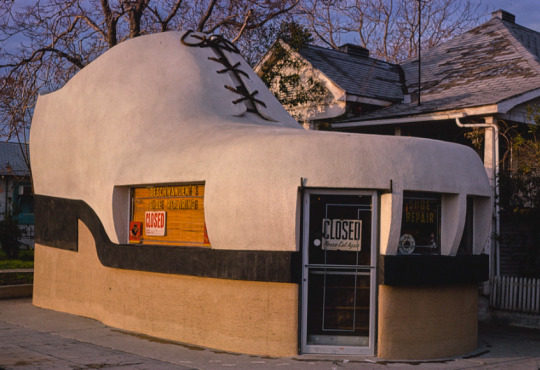
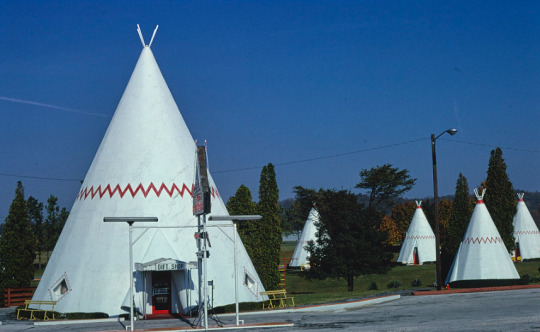


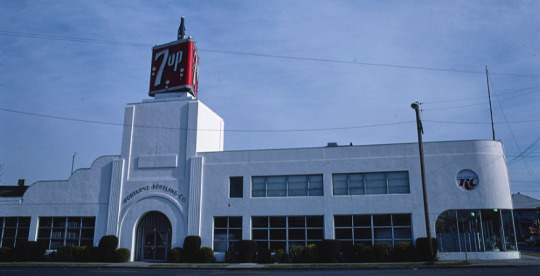
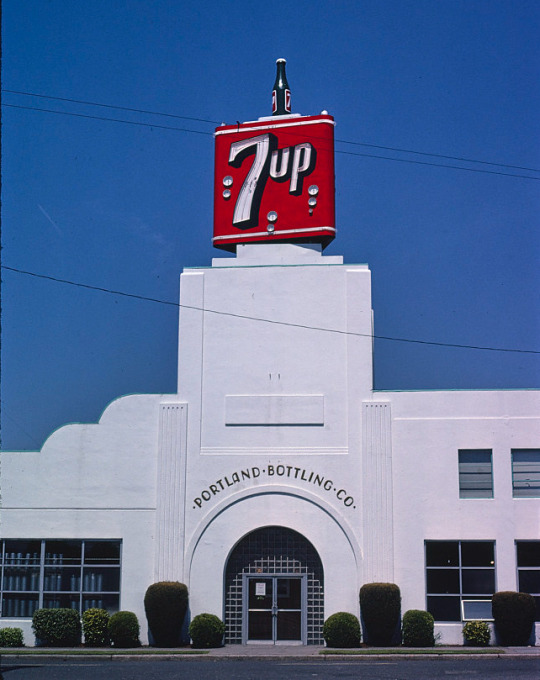


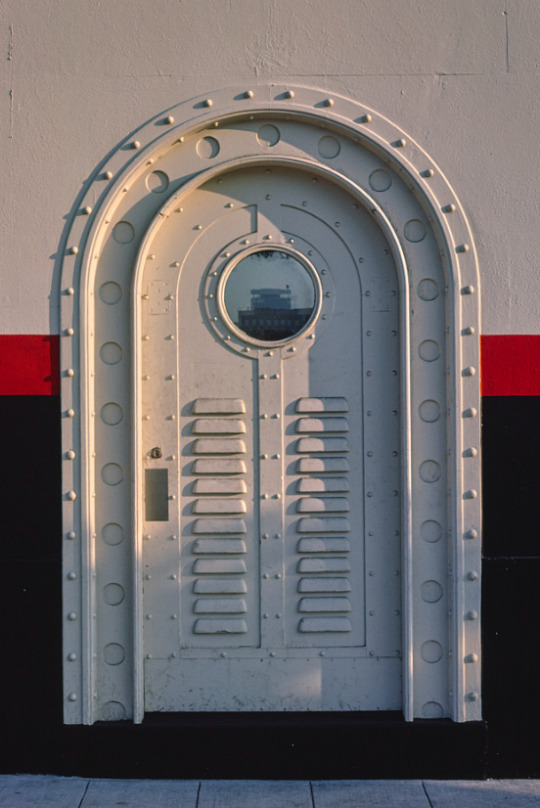
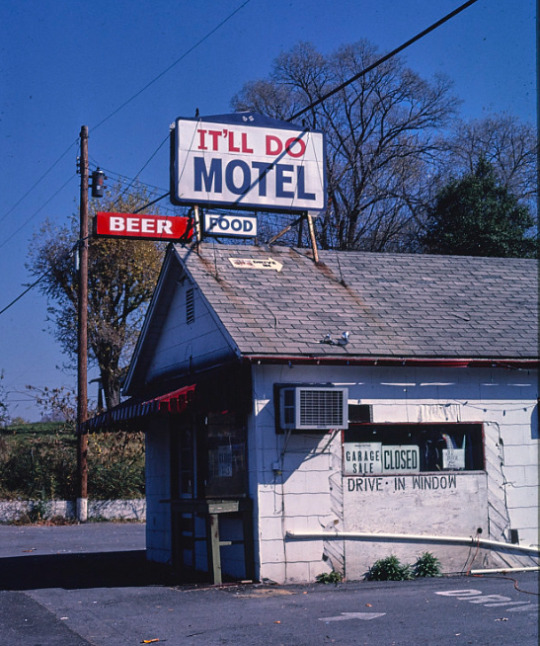

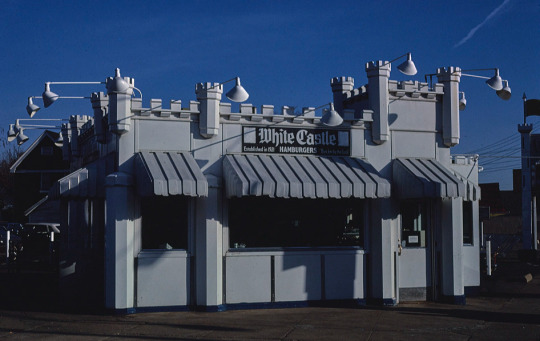

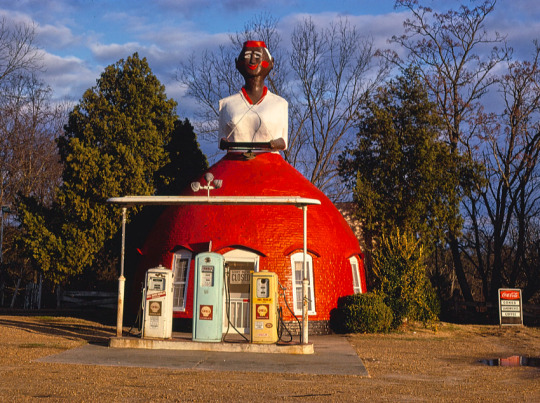
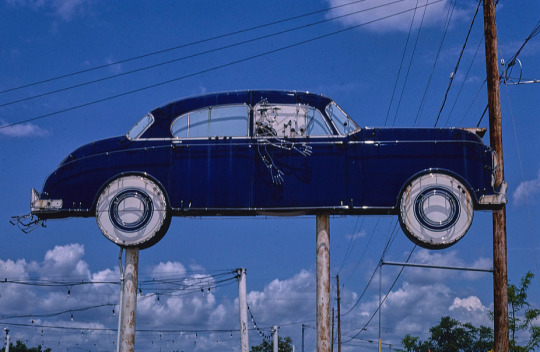






John Margolies (American, 1940-2016)
John Samuel Margolies was an architectural critic, photographer, and author who was noted for celebrating vernacular and novelty architecture in the United States, particularly those designed as roadside attractions. For almost forty years, he documented the most remarkable examples he found, publishing some of his discoveries in books and consigning the rest to an archive, which has now been purchased by the Library of Congress who, in a wonderfully gracious move, have lifted all copyright restrictions on the photographs. (see link below)
Gatorland Zoo alligator statue - Route 1, St. Augustine, Florida - 1979
Deschwanden's Shoe Repair (The Big Shoe) - 10th & Chester, Bakersfield, California - 1977
Wigwam Village #2 - office teepee and several teepee cabins - Route 31W, Cave City, Kentucky - 1979
Wigwam Village #6 - Route 66, Holbrook, Arizona - 1979
Jantzen sign - Stamie's Beachwear - Ocean Avenue, Daytona Beach, Florida - 1990
7-Up Bottling Company (two views) - NE 14 & Sandy Boulevard, Portland, Oregon - 1980
Coca Cola Bottling Company (two views) - 14th & Central Avenue, Los Angeles, California - 1977
Coca Cola Bottling Company (detail view of door) - 14th & Central Avenue, Los Angeles, California - 1977
It'll Do Motel (office) - Jonesborough, Tennessee - 1987
Joy Theater marquee - San Antonio, Texas - 1982
White Castle - Reading Road, Cincinnati, Ohio - 1980
Mammy's Cupboard (two views) - Route 61, Natchez, Mississippi - 1979
Dependable Used Cars sign - Division Street, Grand Rapids, Michigan - 1982
Stan The Tire Man statue - Broadway, Mount Vernon, Illinois - 1988
Bomber gas station - Route 99 E., Milwaukie, Oregon - 1980
World's Largest Redwood Tree Service Station (1936) - Route 101, Ukiah, California - 1991
Peach water tower - Frontage Road, Gaffney, South Carolina - 1988
Christie's Restaurant sign (cowboy shrimp) - Houston, Texas - 1983
Roadside flamingo statue - Frog City, Route 41, Florida - 1980
www.publicdomainreview.org/collection/john-margolies-photographs-of-roadside-america/
addendum: seen (not photographed) in a 2007 trip to Garibaldi/Nehalem/Manzanita Oregon — The Wheeler Inn with a wheelbarrow on the roof with a clothed female mannequin loaded into it . . .
40 notes
·
View notes
Text
I have one (1) person saying they'd like a post about different styles of lighthouses so that's what this is going to be. As lighthouses serve as aids to navigation both during the day and at night, they have to stand out from each other so every lighthouse will look unique in some form or another. On top of that, many lighthouses were built out in the water and their structures had to be able to withstand the harsh weather in the open water (which not all of them did, several structures have been washed away in particularly powerful storms and had to be rebuilt). Under the cut will be several images of various lighthouses and the different classifications of these structures.
The first type of lighthouse we'll discuss in this post is the integrated lighthouse. Wikipedia describes these lighthouses as "...a lighthouse in which the tower and keeper's dwelling are united in one structure." This refers to lighthouses on land almost exclusively, but these lighthouses take on many different appearances. There are some standard designs, such as the school house design used at South Fox Island and Copper Harbor in Michigan (below), and others are more unique in their designs.

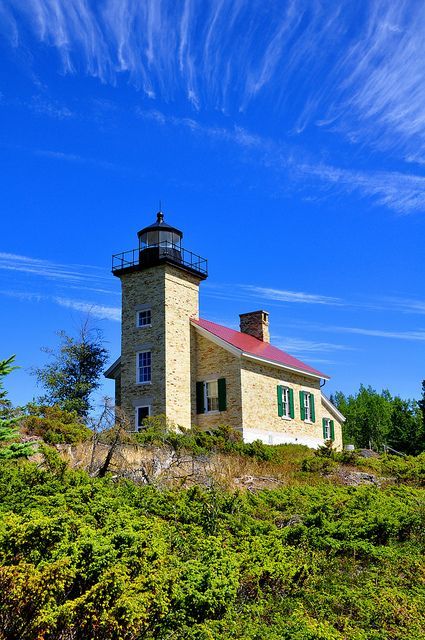
Both of these lighthouses, South Fox Island and Copper Harbor respectively, follow a standard "schoolhouse" design in their basic structure, however to tell them apart, they were given different daymarks, such as South Fox Island's whitewashed brick compared to Copper Harbor's natural cream brick. These differences help sailors to identify which specific lighthouse they're passing by and every single lighthouse will look at least slightly different, especially if it was constructed during the golden age of lighthouse construction, generally considered to be from about 1840-1910 (and obviously lighthouses were constructed before and after this period, but these 70 years saw a huge expansion in lighthouse construction, in part, due to the invention of the fresnel lens and the ability to mass produce them in France).
Not all lighthouses constructed on land are considered to be integrated lighthouses, however. Lighthouses like the one at Cape Hatteras are simply the tower, with the keepers' quarters often being nearby to the structure, but not attached. Cape Hatteras is also one of very few lighthouses bearing a "barber pole" daymark. So far as I can tell, only three lights in the US have this daymark, including St. Augustine in Florida and White Shoal in Michigan (which we'll discuss a little later).
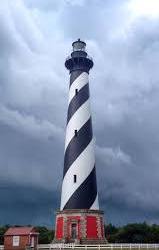

Pictured above: Cape Hatteras Lighthouse, North Carolina, United States // Contis Plage Lighthouse, Landes, France. Both of these lighthouses are towers detached from any keepers quarters.
These are the two most common lighthouses you'll find on land, but what about those lighthouses built on the water? Well, they're divided into a few different categories: Caisson lighthouses, Screw-pile lighthouses, and Crib lighthouses.
Let's start with the Screw-pile lights. These were some of the first lighthouses built out on the water, with their piles being screwed into the mud and sand. These are actually slightly modified from older straightpile or simply pile lighthouses, differing mostly in the shape of the structure. Straightpile lights were taller and more skeletal compared to screw-pile lights. These structures had open legs which helped alleviate some pressure from the waves crashing on the structure, literally just giving them less surface area to hit and damage.
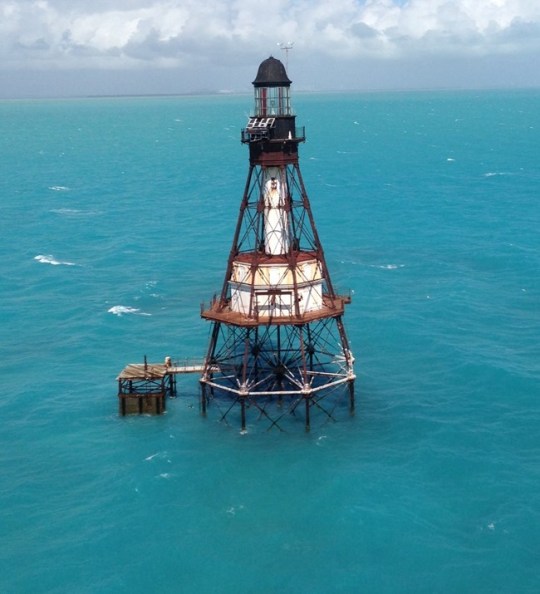
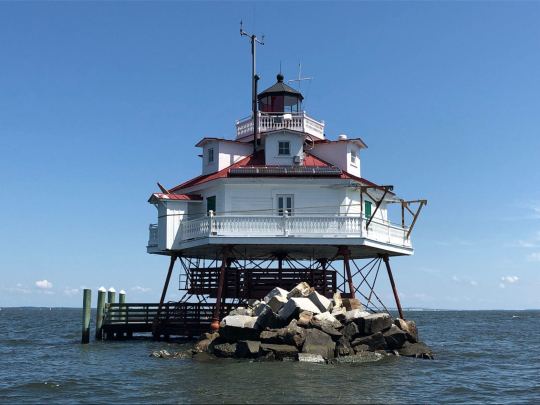
Above: Fowey Rocks Lighthouse, Florida, United States // Chesapeake Bay Lighthouse, Maryland, United States. Fowey Rocks is a Pile Lighthouse and Chesapeake Bay is a Screw-pile lighthouse. Both types of lighthouse included a keepers quarters in the structure above the water on a suspended platform, but are not considered integrated lighthouses like their mainland counterparts.
Caisson Lighthouses were created in response to Screw-pile lights, being both cheaper to build and sturdier as a structure. These lighthouses were built on metal or concrete caissons which were screwed into the sediments, with the rest of the structure completed on top. These lighthouses weren't immune to accidents though, as seen with the Sharps Island lighthouse in Maryland, which was knocked on an angle from an ice floe in 1977 and remains at a tilt to this day. It was decommissioned in 2010.
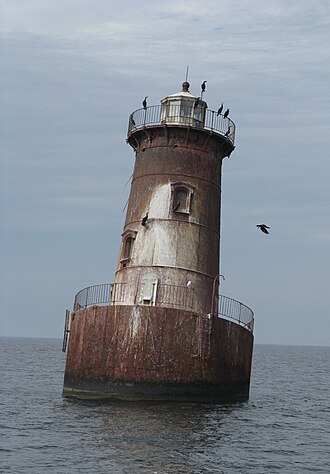
Above: the Sharps Island Lighthouse, Maryland, United States. This lighthouse actually replaced earlier screw-pile lighthouses that were also destroyed by ice floes through the area. The keepers quarters on the last Screw-pile lighthouse was fully lifted off its legs and carried safely away by the ice floe and none of the keepers inside were hurt.
The final type of lighthouse built out on the water are the crib lighthouses. These lights were built on wood and concrete cribs, often in the Great Lakes region due to the composition of the lake beds. The first crib light was built in 1851 on Waugoshance Shoal and more lighthouses soon followed. The most striking of these crib lights is White Shoal, located near Waugoshance, which has the only red and white barber pole daymark in the United States. Both of these lighthouses are located in the Straits of Mackinac region, which has ~15 lighthouses, including several crib lights (Gray's Reef, Poe Reef, and Spectacle Reef, just to name a few).


Above: Waugoshance Shoal Lighthouse // White Shoal Lighthouse, both located in the Straits of Mackinac, Michigan, United States. Waugoshance Shoal sits in just 4 feet of water, making it very difficult to access for repairs and restoration. The lighthouse was used as bomb target practice during the second World War due to it's location inland and the fact that it had been decommissioned in the 1930s. It still retains it's iconic birdcage lantern room, one of only four that survives in the United States.
There is one more type of lighthouse to discuss, and those are skeletal tower lighthouses. Not every skeletal tower light is considered an official lighthouse for a variety of reasons, but there were a number of lights built in this style. They are very reminiscent of pile lighthouses with their open frams, though skeletal towers can be built on shore as well. They became popular due to the relative ease of construction in remote locations, and that they could be deconstructed and reconstructed if need be. One of the most famous lighthouses built in this manner is Whitefish Point, where the modern Great Lakes Shipwreck Museum is located and where you can still go and see the bell of the infamous Edmund Fitzgerald, which was the last major wreck on the lakes occurring in 1975.
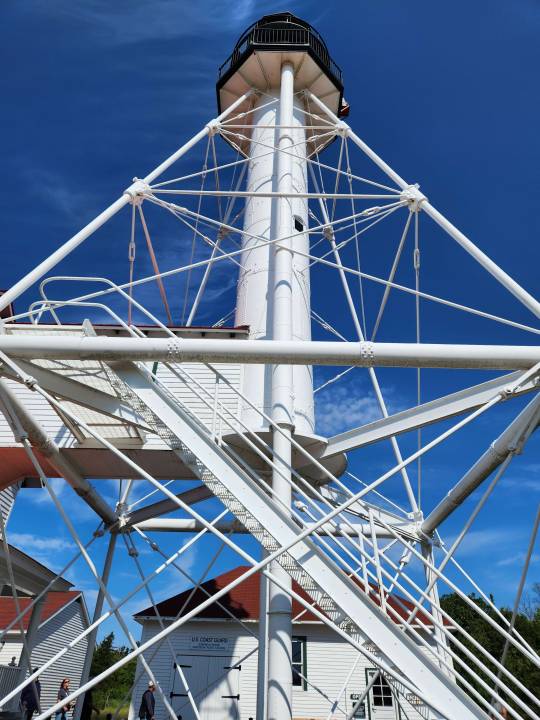
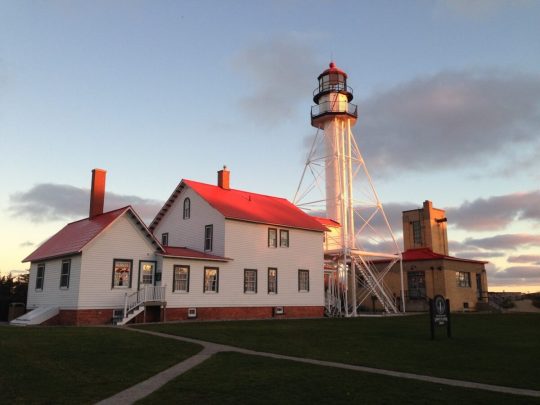
Above: Two different angles of the Whitefish Point Lighthouse. It contains a central staircase in a white column. This lighthouse was not operational during that November gale in 1975 when the Edmund Fitzgerald went down, as the captain noted how inconvenient it was that the light was out in one of his final transmissions. Thankfully there has not been a major shipwreck since then, though shipping culture on the Great Lakes is a whole other post in and of itself.
These are just a few examples of lighthouses, and these structures decorate the coasts of our oceans and several lakes in the world to help ships navigate the rough waters and stay safer on their journeys. I hope you learned something about lighthouses here and can appreciate the effort put into creating them just a little bit more! If you'd like to learn more about American Lighthouses, I'd recommend reading Brilliant Beacons by Eric Jay Dolin, which is where I got a lot of this information, and it includes a lot of anecdotes about lighthouses and their keepers throughout the country.
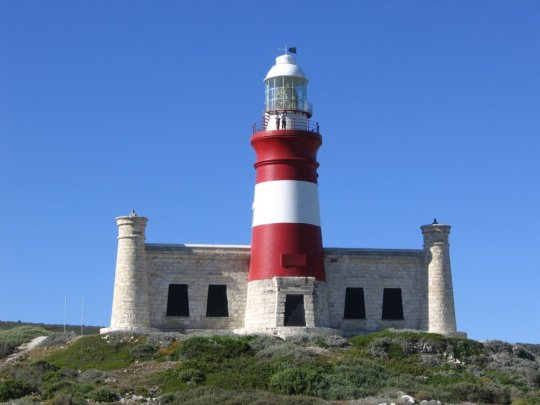
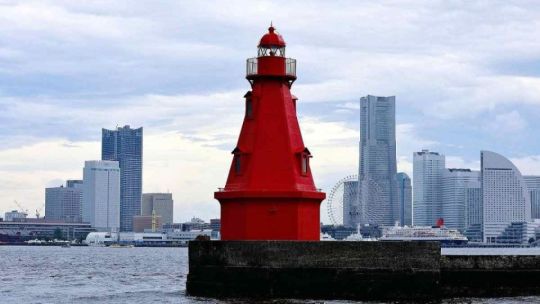
Above: Cape Agulhas Lighthouse, South Africa // Yokohama Breakwater Light, Japan. Just showing some more examples of lighthouses outside of the United States. Can you identify what types of lighthouses these are?
#shay speaks#lighthouses#lighthouse#lighthouseposting#idk what else to tag this with...#well i'm sure it'll find its audience#most photos were taken from wikipedia or public news sites#but i took two of these photos personally myself love and light
28 notes
·
View notes
Text
Lydia O'Connor and Nina Golgowski at HuffPost:
The 133 cardinals who assembled in the Vatican for the top-secret conclave have chosen the Roman Catholic Church’s first U.S.-born pope: Cardinal Robert Francis Prevost. Prevost, who will now go by his selected papal name of Pope Leo XIV, succeeds the late Pope Francis, who died at age 88 last month. Thousands filled the streets of Vatican City and cheered as Pope Leo XIV, a 69-year-old native of Chicago and polyglot with dual nationalities, stepped out on the balcony overlooking St. Peter’s Square to cheers while wearing red and white. His appearance came roughly an hour after plumes of white smoke streamed from a Sistine Chapel chimney Thursday, signaling that a new leader of the Roman Catholic Church ― a faith with more than 1 billion followers ― had been selected by a two-thirds majority vote of the cardinals, the church’s most senior clergy under the pope. “Peace be with you,” he said in his first speech as pope, which he gave in Italian, Spanish and Latin, but not English. [...] Pope Leo XIV is originally from Chicago’s South Side, according to the Chicago Sun Times, and earned a bachelor’s degree in mathematics from Villanova University in Pennsylvania in 1977 before receiving his theology degree from the Catholic Theological Union of Chicago in 1982. After completing his studies in canon law in Rome, he served two decades in Peru, where he worked as a missionary, parish priest, teacher and became the archbishop of Chiclayo, in the country’s northwest. He was also appointed the prior general, or leader, of the Order of St. Augustine in 2001 after joining the religious order in 1977. He became a naturalized Peruvian citizen in 2015 and was brought to the Vatican in 2023 by the former pope, Francis, where he has served as the head of the office that vets bishop nominations. The 267th pontiff was selected after several rounds of voting over two days. In 2013, it took five rounds of voting in under two days for the cardinals to choose Francis. The fastest conclave lasted only 10 hours in 1503, while the longest lasted nearly three years in 1268.
History was made: Cardinal Robert Francis Prevost chose Pope Leo XIV to his Papal name, becomes the first pope from the US (and North America), He is just the 2nd from the Western Hemisphere. Pope Leo XIV was from the South Side of Chicago, and spent most of his career out of the US.
See Also:
Daily Kos: Trump loses another election
The Guardian: Robert Francis Prevost becomes Pope Leo XIV as cardinals elect first US pontiff
Charlotte's Web Thoughts (Charlotte Clymer): An American for Pope and a Great Choice
#Robert Francis Prevost#Robert Prevost#Pope Leo XIV#2025 Papal Conclave#Pope Francis#The Vatican#Roman Catholic Church#Catholicism#Religion
10 notes
·
View notes
Text
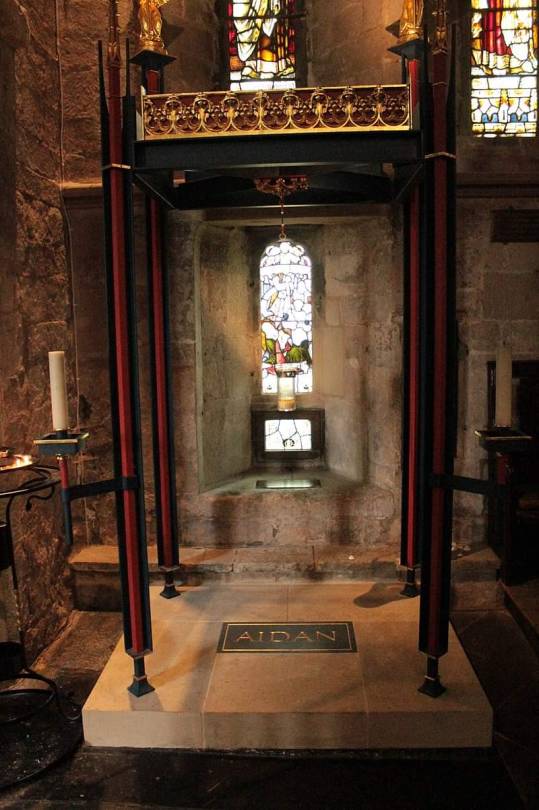
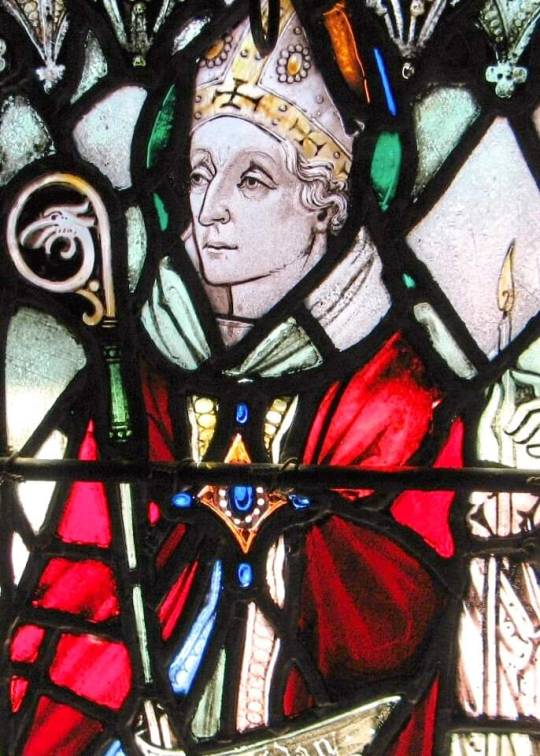
31st of August is the Feast day of St Aidan.
Not much is known about Aidan’s early life, it is thought he was born in Connach Ireland.
St. Aidan began his life of service on the Isle of Iona, the monastery at Iona was established by Irish monks under St. Columba, during the so-called “dark ages.” About a century later, in St. Aidan’s time, the monastery had become a major center of Gaelic Christianity and was receiving and sending monks across Europe.
By this time, Christianity in Northern England was largely replaced by the paganism of both native Britons and the Anglo-Saxon conquerors. The Kingdom of Northumbria (northern England and south-east Scotland) had just been reconquered by King St. Oswald of Northumbria. There was no Scotland or England as such back then, and no real borders Oswald brought the two Northumbrian kingdoms of Bernicia and Deira once again under a single ruler, and promoted the spread of Christianity,the North of Bernica are now part of the South of Scotland.
Oswald took back his father’s throne at the Battle of Heavenfield, where he prepared by praying before a wooden cross, legend says it was a relic of the True Cross. Next, Oswald beheld a vision of St. Columba who promised victory if his generals would be baptized. At council, all agreed to be baptized the night before and victory came to Oswald.
Oswald’s Northumbrian kingdom was small but remarkably diverse. Such was it you could hear at least four languages within the kingdom’s borders and there was a mix of church ruins and pagan sites dotting the landscape. While Christianity was initially brought to Britain by Roman saints, and strengthened by Sts. Gregory and Augustine of Canterbury, it had fallen away from the Britons with the Anglo-Saxon invasions.
When Oswald was killed in battle in 642, Aidan worked equally well with Oswin, king of Deira. Aidan preached widely throughout Northumbria, travelling on foot, so that he could readily talk to everyone he met. When Oswin gave him a horse for use in difficult terrain, Aidan gave it to a beggar soliciting alms. Oswin was angry until, as Bede recounts, Aidan asked if the son of a mare was more precious to the king than a son of God. Oswin sought Aidan's pardon, and promised never again to question or regret any of his wealth being given away to children of God. Both Oswald and Oswin are venerated in England as saints and martyrs.
Scores of Scottish and Irish monks assisted Aidan in his missionary work, building churches and spreading Celtic Christian influence to a degree that Lindisfarne became the virtual capital of Christian England. The saint also recruited classes of Anglo-Saxon youths to be educated at Lindisfarne. Among them was Saint Eata, abbot of Melrose and later of Lindisfarne. In time, Eata's pupil, Saint Cuthbert, also became bishop of Lindisfarne.
Aidan lived a frugal life, and encouraged the laity to fast and study the scriptures. He himself fasted on Wednesdays and Fridays, and seldom ate at the royal table. When a feast was set before him he would give the food away to the hungry. The presents he received were given to the poor or used to buy the freedom of slaves, some of whom entered the priesthood. During Lent Aidan would retire to the small island of Farne for prayer and penance. While there in 651, he saw smoke rising from Bamburgh, which was then under attack by the pagan King Penda of Mercia. He prayed for the wind to change, and many of the besiegers were destroyed by fire.
When Oswin was killed in 651 by his treacherous cousin Oswy, king of Bernicia, Aidan was grief-stricken. The saint outlived Oswin by a mere twelve days, dying in a shelter he had erected against the wall of his church in Bamburgh.
The first pic shows tomb of St Aidan, St Aidan's Church, Bamburgh, the second is a stained glass window depicting Aidan at the Monastic Chapel, Holy Cross Monastery, West Park, New York.
22 notes
·
View notes
Text
rich boys call it love

top!yang jungwon x btm!male reader smut, angst
After the blog makes Y/n’s day unbearable, he disappears—just for a night. Somewhere quiet, somewhere gold-lit. Jungwon’s penthouse is warmer than it should be, his voice softer than Y/n remembers. There’s no pressure. No questions. Just a glass in his hand, the city far below, and a boy who swears he only wants to keep him safe.
a continuation of "rich boys don't lose."
warnings: elitism, power dynamics, degrading, rough sex, unprotected sex, no prep, drugs, manipulation, yandere jungwon, lowkey inspired by gossip girl

Y/n hadn’t expected to sleep. Not after everything. But morning came anyway—unforgiving and too bright, the kind of light that made everything feel exposed. There was no hiding from it, not even under the covers. Especially not from himself.
His body ached in ways he didn’t have names for. His head was heavy, fogged with too many thoughts and not enough answers. He showered in silence, dried off like muscle memory, stared at his reflection longer than he meant to. He couldn’t tell if he looked different. Maybe it was all in his eyes.
The guilt came in slow waves—quiet at first, then heavier the longer he sat with it.
He had walked into that firm. Willingly. Worn something clean, something decent, like he was doing something respectable. Like it wasn’t betrayal stitched into every step he took across that marble floor. He could still hear the way his father’s voice would’ve cracked if he ever found out—that kind of disappointment, the one that doesn’t need yelling to leave a scar.
And worse, he didn’t regret walking in.
Not in the beginning.
That was the part that stung the most. He went for revenge. For the thrill. For some stupid, short-lived taste of control. But he stayed for Jay. For the way Jay looked at him—like he already knew Y/n would fold. And then he did.
Y/n squeezed his eyes shut, jaw clenching.
He’d been stupid. Naive. So fucking easy to read, and easier to use. And now, after everything, he didn’t even know if he hated Jay for what he did—or hated himself for not hating it more.
He sat at the edge of his bed in full uniform, hands limp between his knees, the collar of his shirt suddenly too tight. His stomach twisted.
It wasn’t the blog. Wasn’t the silence. Wasn’t even the fear of someone finding out.
It was the shame.
And not the kind people could see. The quiet kind. The kind that buried itself deep in your chest and echoed when no one else was around.
He had done something he swore he wouldn’t. With someone he swore he hated. In a place he never should’ve been.
And still… a part of him wanted to go back.
That was the worst of it.
By the time Y/n stepped onto campus, St. Augustine’s looked the same. Polished. Controlled. Unreal, in the way all expensive things feel just slightly detached from the world around them.
But something inside him had shifted.
It wasn’t dramatic. There were no fireworks, no breakdowns. Just a dull, persistent weight behind his ribs—like he’d swallowed guilt and it hadn’t dissolved.
His footsteps echoed in the south hallway. No one looked twice.
He passed groups huddled around notes, students half-laughing through their panic, and a few legacy kids too rich to care. His mind wandered through memories he didn’t ask for—Jay’s voice, Jay’s hands, the heat of that glass wall pressing into his cheek like it could swallow him whole.
He tried to shake it off.
Then he saw Jake.
Just outside the lecture hall, casually leaned against the wall, one hand in his pocket, the other spinning a pen between his fingers like he was born to make everything look easy. His hair was perfect. Smile half-there. People around him—two girls, one guy—were practically orbiting.
And yet, Jake was staring directly at him.
Not for long. Just a flicker. A glance that felt like it held too much weight and not enough care. Then Jake looked away.
He didn’t say hi. Didn’t smirk. Didn’t slide in close to whisper something suggestive like he usually did.
Y/n hated that it got to him.
Inside the building, Sunghoon was sitting on the windowsill near the library’s east wing. One leg crossed over the other, a hardcover resting on his lap like he might open it, though he clearly had no intention of doing so. His uniform was immaculate. Posture perfect. Not a single crease out of place.
He didn’t look up as Y/n passed. But he didn’t have to.
His stillness was enough.
Sunghoon didn’t need to speak to make you feel like you were being watched. Judged. Picked apart in silence.
Y/n walked faster.
He pushed open the classroom door, hoping to get to a seat unnoticed. He didn’t. Someone called his name—softly, politely—and when he turned, it was Jungwon.
Jungwon was always polite.
He had a smile that felt genuine. A warmth in his voice that didn’t seem rehearsed. There were rumors about his family—something about luxury hotels overseas, always in the best parts of the world—but Jungwon never bragged. Never even brought it up.
“Hey,” he said, nodding to the empty seat beside him. “Sit?”
Y/n blinked. Then nodded.
It wasn’t that they were close. They weren’t. But there was something calming about Jungwon’s presence—like he hadn’t yet learned how cruel people could be, or maybe he had and chose to ignore it.
“You okay?” Jungwon asked quietly, once Y/n was seated.
Y/n hesitated. “Just tired.”
Jungwon didn’t press.
Class began. Y/n tried to focus. Tried to listen. Tried to keep his hands steady and his breathing even and his thoughts anywhere but there.
But then—Jay walked in.
Late, of course. Always late.
His tie was loose. Shirt unbuttoned just enough to show collarbone. He wore arrogance like cologne—light, expensive, and unmistakable. He walked past the professor without flinching, slouched into a chair three rows ahead, and—without even turning—smirked.
Y/n didn’t need to see his face to know.
He could feel it.
And Jungwon, maybe sensing the shift, nudged Y/n gently beneath the desk. Not invasive. Just… present.
Y/n swallowed hard. Tried to nod. Tried to be grateful.
But all he could think about was the wall. The heat. The sound of Jay’s voice in his ear.
And how he had let it happen.
Y/n kept his eyes on the front of the room, but his mind refused to stay there. The words on the board blurred. The professor’s voice was distant, muted, like it was coming from behind glass. His pen tapped against the desk—not loud, but steady enough to annoy himself.
Then his phone buzzed.
Once. Twice. Then silence.
He didn’t check it immediately. Didn’t have to. He knew that kind of silence—the way the air shifted just slightly, the way people stopped pretending they weren’t scrolling through something they shouldn’t be reading.
Y/n reached for his phone slowly, already bracing for it.
New post. Fresh. Barely a minute old.
"Some people will do anything for attention. Even walk into buildings their fathers would rather set fire to."
"But it’s okay. No one saw, right?"
"Except the cameras." "And us."
"Hope it was worth it."
Below the caption was a photo. Grainy, but clear enough.
Y/n. Walking through the polished lobby of Park & Co. Head high. Shoulders back. Like he belonged there.
His stomach dropped.
The picture wasn’t incriminating. Not directly. There was no context, no timestamp, no tag. But St. Augustine didn’t need context. It needed implication—and the blog always knew exactly how to weaponize that.
Jungwon shifted beside him, glancing at his own screen. His brows knit, just barely. He didn’t say anything, but Y/n felt the weight of it anyway.
Three rows ahead, Jay didn’t move.
Not at first.
But then his head tilted—subtle, slow—and one hand rose to his mouth, like he was covering a laugh that never made it out.
Y/n’s ears burned.
He stared straight ahead, chest tight, fingers curling around the phone still resting in his lap.
He should’ve known.
Silence here was never peace. It was just the calm before your name turned into currency—passed between hands, whispered behind backs, traded in looks.
And his time was up.
The room hadn’t changed, but it felt like it had. The light overhead was too cold. The walls too still. Something about the air made his skin itch, like the oxygen itself had been replaced with attention.
He didn’t look around, but he didn’t need to. He could feel it. The shift. The pull. A flicker of someone’s eyes. The edge of a whisper barely concealed behind a hand. Fingers scrolling too quickly to be subtle. He could hear the rustle of screenshots being taken in silence.
Y/n’s jaw clenched, his fingers wrapped tight around the pen in his lap, like if he held it hard enough, it would anchor him. Like it could ground him through the rush of heat crawling up his neck.
He had known this would happen. Had felt it the second he stepped into that firm, the second the elevator doors shut behind him.
But knowing didn’t make it easier.
It wasn’t just the blog post. Not really. It was the weight of what it implied—what it didn’t say. Because that was always the most dangerous part. The blog never needed to state names or tell the whole story. It only had to point. And people would fill in the blanks with whatever version of you they wanted to believe.
Three rows ahead, Jay was lounging like he belonged to the room. Like the tension didn’t touch him. He hadn’t looked back once. He didn’t need to. The way his fingers tapped idly against the desk, the tiny tilt to his head—he was comfortable.
He was proud.
And Y/n hated him for it.
The class dragged on, the professor’s voice bleeding into white noise. Y/n didn’t catch a single sentence. His knee bounced under the desk. He kept his hands in his lap, trying not to scroll, not to re-read. But it was there anyway—the post, the photo, the words—that sick feeling in his gut that told him this wouldn’t go away in a day. Not like the others. Not like before.
And beside him, Jungwon sat quietly, shoulders still, eyes forward. He hadn’t said a word since class began, but Y/n felt the glance when the post dropped. He’d seen it too.
They all had.
When the class finally ended, the scraping of chairs sounded louder than usual. Y/n moved fast—shoving his things into his bag, movements stiff, mechanical. He just wanted out. He needed air. He needed—
“Hey,” Jungwon said softly. “Are you—”
“I’m fine.”
It came out too quick. Too sharp. He knew it the moment it hit the air.
Jungwon blinked, startled, but nodded once and said nothing else.
Y/n didn’t wait. He walked out with his head low and his heart somewhere behind his ribs, thudding against the bones like it wanted out.
He didn’t know where he was going. Just that he needed to not be seen for a second. To be alone.
But alone wasn’t something you got here.
Not after the blog had your name in its mouth.
The hallway was colder now. Or maybe Y/n was just noticing it—how the air curled under his collar like fingers brushing his spine. His steps echoed louder than usual, even though no one looked his way. He could feel eyes, though. Imagined or not. They pressed against his back the way shame sometimes did—soft at first, then unbearable.
He didn’t head to the dining hall. Didn’t head to the courtyard. Instead, he just… wandered. Let the corridors guide him, let his thoughts spill into the gaps between footsteps. And god, there were so many thoughts.
Jake. The way his hands always found Y/n’s thighs under tables. The way his voice dropped in empty hallways just to say things no one else should hear. He never asked, never warned—just touched, lingered, hovered. And yet… Y/n never pulled away. Jake knew that too. That’s what made it worse. There was something behind his gaze, something too focused to be casual. Something that clung to Y/n like heat.
Then there was Sunghoon. Cold. Controlled. Beautiful in that way porcelain is—untouchable, expensive, sharp when cracked. What happened between them hadn’t been warm, but it had left heat behind. A bruise blooming just beneath the skin, one Y/n kept pressing on. Sunghoon never asked for anything, just expected it. And Y/n gave it. Willingly. That was the part that rattled.
Jay… was different. Violent, almost. Not in action—at least not always—but in presence. He overwhelmed, consumed. Every word a taunt, every touch a dare. But it hadn’t been forced. That was the worst part. Y/n could’ve left. Could’ve said no. But he didn’t. Something about the way Jay pulled him apart made him stay. Something about being seen in all the wrong ways, and still wanted.
Except… none of them really wanted him. Not the way that mattered. He was a game piece. A distraction. A moment of entertainment before the next scandal rolled in. And he’d let himself be moved across their board like it didn’t hurt. Like it didn’t leave cracks.
“Hey.”
Jungwon’s voice broke through the fog—gentle, light, as if he hadn’t been following Y/n through the crowd, letting the space between them close slowly.
Y/n turned. He tried for a smile, but it felt thin, like a bandaid over something bleeding. Jungwon didn’t seem to mind. He stepped closer, eyes soft, searching.
“You don’t have to talk,” he said quietly, “but if you need to get away… I have a place.”
Y/n blinked. “A place?”
Jungwon nodded once, that same soft smile tugging at the corners of his lips. “My parents’ penthouse. Upper East Side. They’re gone until the weekend.”
Y/n hesitated. Not because of the offer, but because it sounded so… kind. So safe. No sharp edges. No expectations.
“No pressure,” Jungwon added, like he could read every hesitation as it formed. “Just thought you might want quiet. Real quiet.”
Y/n looked at him. Really looked. At the way Jungwon held himself—gentle, noninvasive. There was no glint of challenge in his gaze. No games. Just calm.
And yet, something about it didn’t feel small. It felt intentional.
Still, Y/n nodded. “Yeah… maybe.”
“Later tonight?”
“Okay.”
They stood there for a moment—neither moving, neither quite knowing what to say. Then Jungwon smiled again, said he’d text the address, and slipped away with all the grace of someone who didn’t need to be noticed to matter.
Y/n turned toward the gates, the end of the day pressing down on his shoulders. His driver would be waiting out front, same as always. He just needed to get there without running into—
“Y/n.”
The voice stopped him cold.
Not loud. Not urgent. Just… familiar.
He turned.
Jake stood beside the black car waiting at the curb, his own driver leaning against the hood, disinterested. Jake’s tie was loose again, blazer slung over his shoulder like it was an afterthought.
He didn’t smile. Just looked. Quiet. Intent.
And Y/n?
Y/n froze.
Because some things, no matter how far you run, find you again at the car door.
Jake didn’t say anything right away. He just leaned against the sleek black car like it was an extension of himself, hands in his pockets, posture loose but watchful. His eyes flicked over Y/n in a way that wasn’t sharp, but wasn’t soft either—just aware. Present. He looked like he was debating something, jaw tight, tongue pressing to the inside of his cheek before he spoke.
“If you ever need anything…” Jake started, then paused. His gaze shifted away for a second, toward the other side of the street, like the sentence had slipped out before he could stop it. “I don’t know. Just—let me know.”
The words landed awkwardly between them. Not forced, but unpolished. Like Jake didn’t know how to be sincere unless he was three drinks deep or had you against a wall.
Y/n didn’t answer. Not because he didn’t hear him, but because he didn’t know what to do with it. His fingers twitched slightly at his side, like the impulse to respond physically—to shrug it off, to scoff, to pretend it hadn’t happened—was fighting with something else. Something that made his stomach twist.
Because for all the wrong things Jake had said to him, all the times he’d brushed fingers too low or let his hand linger too long, this felt… worse. Not cruel. Not manipulative. Just real. And Y/n didn’t know what to do with real.
Jake must’ve felt it too, that weird shift in the air between them, because he didn’t say anything else. Didn’t press. He just gave a single nod—tight, barely there—before pulling open the door to the car.
He climbed in without looking back.
The door shut with a dull click, the kind that echoed more than it should have.
Y/n stood on the curb, the breeze tugging lightly at the hem of his uniform. He caught a glimpse of himself reflected in the car’s tinted windows—half-there, distorted by the glare. He looked tired. Small. Like someone standing too close to something they didn’t understand.
And somehow, that felt exactly right.
He didn’t know what that moment with Jake meant. Didn’t know if it was an apology, or a warning, or just another loose thread waiting to unravel. But it scared him more than if Jake had smirked and said nothing. Because there was something worse than being used.
It was being seen.
The ride back to his building was quiet.
Too quiet.
The kind that made you feel like your own thoughts were too loud, like they bounced off the inside of the car and came back sharper. Y/n didn’t even look at his phone. He didn’t want to know what else the world had to say about him today.
By the time he stepped into the penthouse, the silence followed.
Everything was exactly where it always was. Polished marble floors. Soft lights. Furniture picked for form, not comfort. He could still smell whatever the cook had prepared earlier, though no one had waited for him to eat. Not that he expected them to.
His father was probably still downtown—working late, making calls, pulling whatever strings were left to pull in a city that only respected you when you bled for it. He’d spent years trying to make their last name mean something. Not just money, but legacy. Respect. Something that couldn’t be whispered away in scandals or erased in blog posts.
His mother? Probably out again. Some charity dinner, some silent auction. She was always moving, always smiling, always just out of reach.
It was just him.
The door clicked shut behind him, and Y/n didn’t bother turning on more lights. The apartment was already dim, the Manhattan skyline stretching out behind the windows in a wash of steel and blue. The sky looked cold—muted grays bleeding into deeper ones. Not quite night, not quite day. That in-between hour where everything felt a little too honest.
He dropped his bag at the entrance, kicked his shoes off without care, and sank onto the edge of the couch like gravity had finally caught up to him.
The silence wasn’t peaceful. It was heavy. Draining. Like the whole day had wrung him out and left him hollow.
His mind drifted—back to the classroom, the way Jungwon had looked at him. Not with pity. Not with amusement. Just… with presence. Like he didn’t want anything from him. Like he could hold space for what Y/n couldn’t say out loud.
And then, there was the offer.
“You should come by sometime,” Jungwon had said, casually. “My parents are out of town. It’s quiet. I think you’d like it.”
Upper East Side. A penthouse. Of course.
He hadn’t committed to it. Just nodded. Just said he’d think about it.
And now, with the apartment swallowing him whole, the echo of everything he’d done sitting too close to the surface, he found himself actually considering it.
Not because he wanted comfort. Not even because he thought Jungwon could give it.
But because he was tired.
So fucking tired of being alone in rooms that looked like they belonged in magazines. Tired of sitting in silence while the weight of Jake’s hands still burned on his hips, while Sunghoon’s gaze still lived on the back of his neck, while Jay’s voice still played like static in his ear.
They’d all touched him.
In different ways.
Jake with the softest cruelty—fingers brushing his thigh, tongue in his mouth, acting like it meant nothing and everything all at once. Like he was just collecting pieces of Y/n to keep in his pocket. And yet, somewhere in the space between Jake’s smirks and his silences, there was something else. Something darker. More possessive. It wasn’t love. It wasn’t kindness. But it was close enough to almost feel like care.
Sunghoon had been colder. More brutal. A storm in stillness. He never needed to say much—his hands had done the talking. Y/n remembered the way he was pinned to tile and marble, remembered the teeth, the hands, the demand. It should’ve made him feel small.
It didn’t.
It made him feel something he wasn’t proud of. Something deeper. Like maybe being wanted—even cruelly—was better than not being seen at all.
And Jay. Jay was chaos. Fire dressed in privilege. Y/n had walked into that office thinking he had the upper hand and left with handprints on his skin and a part of himself he didn’t know how to name. Jay hadn’t lied to him. Hadn’t hidden behind charm. He’d used him—completely, thoroughly—and Y/n had let him. Had wanted it.
That was the part that kept him up.
Because some fucked-up part of him liked it. The powerlessness. The control. The shame.
His fingers twitched in his lap.
He leaned forward, pressing his elbows to his knees, staring down at the silent city. Manhattan looked beautiful from up here—unreachable, indifferent. He hated it for that. He hated that it looked cleaner than he felt.
The invite from Jungwon sat in his mind like a soft light through a crack in the door.
He didn’t know what he expected from it. Maybe nothing. Maybe just a break from the noise. Or maybe the illusion of being wanted for something other than how easily he could be broken.
His phone buzzed again.
He picked it up.
Jungwon: Let me know when you’re on the way. Elevator will be open for you.
Y/n stared at the message, thumb hovering over the screen.
And for the first time all day, something in his chest shifted.
The hours passed in fragments.
Time didn’t move the way it usually did—no clean rhythm, no steady pull toward evening. It dragged. Slow. Sludgy. Like the day itself had gotten stuck somewhere and was refusing to end.
Y/n didn’t move much from the couch. Just shifted positions when the stiffness got too uncomfortable. Once onto his side, once back again. The TV played in the background—something muted, some show he wasn’t really watching. His phone lay face down on the coffee table. He hadn’t touched it in hours.
Every now and then, a housekeeper passed through the room—quiet, efficient, polite in the way expensive training taught you to be. They didn’t ask questions. Didn’t hover. One of them brought a tray with tea he hadn’t requested. Another adjusted the pillows near his feet, like that might help somehow.
He offered them a small nod, a quiet thank you, and they disappeared again.
It wasn’t pity. It was caution. They were trying to be kind without being noticed. Trying to make things feel normal without asking why he looked like a ghost in his own home.
He hated that it helped.
His eyes drifted to the edge of the coffee table, then to the phone.
He thought about Jake again.
About that moment outside the gates, the way he’d spoken—not teasing, not cruel, just… off. Like the words didn’t come naturally. Like he’d meant them more than he wanted to admit.
“Let me know if you need anything.”
Y/n had replayed it once. Then twice. The tone, the weight, the way Jake looked at him. It hadn’t felt fake. Not quite. But it hadn’t felt selfless either.
Nothing Jake did ever was.
He wondered if Jake actually cared. If that line was his version of concern—or just another way to keep Y/n tangled in his orbit. A soft leash instead of a hard grip. A hint that he still had a hold, even when he didn’t tug.
It didn’t matter.
He wasn’t going to text him. Not tonight.
Y/n turned his head to the windows. The sky was darker now, bleeding into the kind of purple that Manhattan wore well. Lights flickered on across the skyline like stars that cost too much.
He exhaled. Slow. Deep. Letting the weight settle again.
His eyes dropped back to his phone.
Jungwon.
He still hadn’t answered the message. Hadn’t confirmed anything. It would’ve been easy to stay right where he was, blame the mood, claim exhaustion. To not go. To disappear into his own silence.
But something about that didn’t sit right.
Jungwon hadn’t asked for anything. Hadn’t pushed. He’d just been… there. Present in a way that didn’t demand anything from him. Kind, but not performative. Soft, but not naïve.
It wasn’t the kind of comfort Y/n was used to. But maybe that’s why it stuck.
And maybe, after everything—after Jake’s cold looks, Sunghoon’s judgment, Jay’s cruel smirk—maybe he didn’t want to feel wanted.
Maybe he just wanted to feel normal.
Y/n pushed himself off the couch with a groan, limbs stiff from too long in one place. He stretched, rolled his shoulders, ran a hand through his hair and blinked at the weight behind his eyes.
Then he turned and made his way to the bathroom.
The water ran hot, almost scalding, but he didn’t flinch. He stepped in and let it soak into his skin, let it press the day out of his muscles, let it melt the stiffness from his limbs. The steam rose thick around him, curling against the mirror, fogging out the pieces of himself he didn’t want to see. He washed slowly, methodically, as if the warmth could erase everything that had happened—if only for a little while.
By the time he stepped out, the bathroom was a cloud. His skin was flushed, his breath calmer. Not whole, but clearer.
He dressed in something soft. Comfortable, but decent. Just enough to say I’m okay without having to lie.
He picked up his phone. Typed out a short reply.
Y/n: I’ll be there tonight.
No emoji. No extra words.
He didn’t need them.
It wasn’t about what Jungwon wanted. Or what the blog would say. Or what the others would assume.
It was just… something to do. Somewhere to go. A break in the noise.
He set the phone down and stood at the window for a while, watching the city flicker to life.
And somewhere beneath the shame, beneath the exhaustion, beneath the day that had drained him down to his bones—there was a flicker of something else.
Something small. Something quiet.
Maybe not hope.
But something close.
Y/n left the apartment just after nine.
The air outside bit against his skin in that early spring way—sharp, clean, tinged with the perfume of wet concrete and distant traffic. His driver stood by the car with the door already open, waiting in that familiar stillness that came with being paid well enough not to speak unless spoken to. Y/n nodded once in greeting and slid into the backseat. No words. No music. Just the thrum of tires on pavement and the way the city slid past the windows like a memory too fast to grasp.
He spent the ride thinking—not in full thoughts, but in fragments. Flashes. Jake’s face outside the gates. Sunghoon’s silence. Jay’s smirk in the classroom like he hadn’t done anything at all. It all blurred into a low ache in the back of his skull, quiet but insistent, pressing down with every block they passed.
The Upper East Side was different at night. Calmer. Richer. Less of the neon chaos of downtown and more of the kind of quiet that came with old money—money that didn’t have to announce itself because it had already bought the world twice over. The building Jungwon lived in was like that: tall, discreet, with doormen that didn’t look twice and an elevator that opened directly into the apartment with a soft chime.
Y/n stood there for a second. Just long enough to ask himself why he was doing this. Why, after the week he’d had, he was still showing up at someone else’s door—why he still wanted to be seen.
But the door opened before he could think himself out of it.
And there was Jungwon.
No shoes. A soft, oversized sweater hanging loose on his frame. His hair slightly mussed, like he’d been laying down a moment ago. “Hey,” he said, warm and simple, like he hadn’t been waiting but somehow still expected him. “Come in.”
The penthouse didn’t feel like most he’d seen. It wasn’t sterile or cold or dripping in sleek, impersonal design. It felt like someone lived there. Really lived. There were floor-to-ceiling windows, yes—but also heavy curtains, half-drawn. Plush armchairs. A shelf of records and another lined with books, not for show but for reading. A fireplace sat low and humming. A candle burned near the kitchen in a cut-glass jar, citrus and sage curling through the air like a soft reminder that this place had soul.
Jungwon didn’t offer a tour. He didn’t need to. Everything about the space felt natural—like an invitation already extended.
Y/n stepped inside slowly, scanning the room like it might vanish if he blinked too fast. A glass of water already sat on the edge of the counter. The lighting was low, golden, as if even the lamps understood that tonight required softness.
“How was your day?” Jungwon asked, voice barely above a murmur.
Y/n didn’t answer right away. He crossed to the window instead, gaze catching on the skyline—those too-bright towers stacked against a navy sky, everything shining and hollow. “It was loud,” he said after a beat. “Even when no one was speaking.”
Jungwon didn’t ask for more. Didn’t nod like he understood. He just stood beside him for a moment, shoulder not quite touching, and let the silence settle like dust between them.
They didn’t talk about the blog. Or Jay. Or the photo. Jungwon didn’t try to guess how it had felt to see his own shame stamped beneath a caption meant to humiliate. He didn’t ask what Y/n had expected when he’d walked into that firm, or why he hadn’t run the second things turned cruel.
Instead, he walked toward the couch and sat down with the kind of ease that invited company without needing to ask for it.
Y/n followed a moment later, sinking into the cushions with a breath he hadn’t realized he was holding. The fabric was soft against his skin. Everything was. The room, the air, the moment.
“Do you want music?” Jungwon asked, already reaching for the small remote on the coffee table.
Y/n shook his head. “It’s okay like this.”
And it was.
They sat in the hush together, the kind that didn’t press against your ribs. That didn’t require performance. For once, Y/n didn’t feel like a puzzle people were trying to solve. He wasn’t being picked apart, or pulled in two different directions.
He was just… here.
Jungwon leaned forward slightly, elbows resting on his knees, fingers loosely laced. “You don’t have to say anything,” he said. “Just stay. However long you need.”
Y/n nodded slowly, the movement more instinct than agreement.
Because he didn’t know how long he needed. He didn’t even know what he needed. But for the first time in days, something about this—about Jungwon’s quiet, about the way the penthouse held warmth without trying too hard—felt like enough.
He looked at Jungwon then, really looked. His profile in the light. The way his lashes shadowed his cheeks. The slight crease between his brows, like he was thinking too much but refusing to let it show.
There was something in Y/n’s chest that tugged a little.
Not want.
But comfort.
And maybe, for tonight, that was more important.
Y/n hadn’t meant to compare. But it happened anyway.
The moment his shoulders sank into Jungwon’s couch, his mind reached for the contrast—how his own penthouse, though taller, grander, and dressed in marble, felt like it belonged to someone else. His home was quiet in a different way: cold, vast, empty. Everything was curated, stylized, too pristine to be lived in. No warmth. No sound. Just a cavernous hush that echoed beneath his footsteps and swallowed them whole. A place meant to impress, not comfort.
Here, in Jungwon’s world, everything felt different.
The penthouse wasn’t any less luxurious—of course not. Y/n recognized the money in the bones of the place: in the dark oak floors, in the subtle weight of the linen curtains, in the hand-carved molding that held no need to be admired. This was old money, confident money—the kind passed down through bloodlines and black-tie legacies. But there was softness here, too. A lived-in warmth that money couldn’t buy. A kind of gentleness in the furniture, in the way the lamps cast golden halos on the walls, in the candle burning low on the coffee table, citrus and clove curling through the air like memory.
It wasn’t just a home. It was a haven. A place that had seen people cry and laugh and sit in silence without having to fill it.
And Jungwon matched it.
He was curled at the other end of the couch, sweater sleeves covering half his hands, his frame relaxed, gaze soft but unreadable. He didn’t push. Didn’t pry. He didn’t offer empty comforts or reach for Y/n’s wrist like he could fix the tension pulsing beneath his skin. He simply stayed. Steady. Present.
“Want a drink?” he asked eventually, voice barely above the sound of the record playing in the background.
Y/n nodded. “Yeah. I think I do.”
Jungwon returned from the kitchen with two glasses of red wine—deep and velvety, probably something that cost more than most weekend vacations. Y/n took his glass and drank. Slowly, at first. Then more. He wasn’t trying to get drunk. Just… quieter. Softer. He wanted the sting to fade. The thoughts to dull around the edges.
Halfway through the second glass, his cheeks felt warm. His limbs a little loose. The kind of floaty where you can feel your thoughts stretching out, soft and slow, like they’re underwater.
But Jungwon didn’t say anything about it. Just sipped his own wine, fingers curled gently around the stem, eyes occasionally drifting toward Y/n like he was checking on him—not watching. Not calculating. Just… there.
“You can stay the night,” Jungwon said eventually, like it had just occurred to him again. “The guest room’s ready.”
Y/n didn’t answer right away. He stared into the red sheen of his wineglass, then nodded. “Okay.”
“Come on. I’ll show you.”
The walk down the hall felt slower than it should have. Maybe it was the wine. Or maybe it was the way everything here felt too quiet. Too soft. Like walking through a museum after hours—velvet roped and glass cased, but humming underneath with something you couldn’t quite name.
The carpet muffled their steps. The lights burned a muted gold, like the whole penthouse had been dimmed to match a mood Y/n hadn’t known he needed.
Jungwon stopped in front of a door.
“This one,” he said, voice light, hand already on the knob.
And then he opened it.
Y/n took a step in.
And froze.
It didn’t hit him all at once. At first, the guest room looked… normal. Elegant, even. Wide bed, thick blankets, floor-to-ceiling windows, the city glittering just outside. But something in the air shifted—an invisible pull dragging his eyes to the far wall.
His breath caught.
Photos.
Dozens. Maybe more.
Framed in black. Perfectly aligned. A full wall of surveillance.
All of them were of him.
At first, he thought he was mistaken. But then—
There he was. Head tilted, lip bitten, standing just outside Jake’s guest room door.
There again. Blurry. Reflected in a bathroom mirror. Sunghoon just out of frame.
Another—seated on the edge of a leather couch in Park & Co., one foot tucked behind the other, waiting.
Another—pressed against a glass wall. Jay’s shadow behind him.
The longer he looked, the clearer they became. All grainy. All distant. Some zoomed in just enough to catch the expression on his face. Some taken from angles no one should’ve been able to get.
And more—dozens more. Him walking alone. Looking over his shoulder. Standing too close to someone. Laughing when he thought no one saw.
He didn’t know how long he stood there.
Behind him, Jungwon didn’t move. He hadn’t even stepped fully into the room. Just leaned lightly against the doorframe, wine glass still in hand, as if none of it was strange. As if it was all just… decoration.
“As promised,” Jungwon said softly. “No one else uses it.”
Y/n didn’t turn around. Couldn’t. His throat felt dry. His skin buzzed like it wanted to peel off. But his feet—his feet stayed planted.
And behind him, Jungwon smiled. Still gentle. Still kind.
Like nothing was wrong at all.
Y/n’s breath caught, sharp and cold.
The kind of cold that didn’t come from the room, but from inside. From that place in your gut where your instincts live—where something ancient and primal whispers: run.
But he didn’t.
He couldn’t.
Because Jungwon was still there. Barefoot, calm, glass of wine dangling from his fingers like this was just a normal night. Like the wall behind Y/n wasn’t a collection of stolen moments and personal invasions. Like it wasn’t evidence.
And he still smiled.
That same soft, warm smile that made people trust him. That made Y/n trust him.
“You don’t have to be afraid,” Jungwon said, taking another slow step forward. “It’s not what you think.”
Y/n’s throat was dry. He turned slightly, just enough to keep the wall in his periphery. “Then what is it?”
Jungwon didn’t answer at first.
He looked at the photos again, tilting his head as if he were admiring them. Like they were art. His voice was low when it came—measured, careful.
“I just wanted you to know how much I see you.”
He said it like it was a gift.
Y/n blinked, trying to process, but his thoughts were already moving faster than his body. He looked at the photos again—Sunghoon in the stall. Jake’s guest room. The glass wall at Park & Co. All places he thought had been private. All moments he thought were secrets.
The blog always knew.
And suddenly it clicked.
Not like a lightning strike. Not a dramatic gasp or world-shattering realization. Just… a slow, sick unfurling in the pit of his stomach.
Jungwon didn’t ask about the post because Jungwon knew about the post.
He knew before it went up.
He always knew.
The timestamps. The tone. The way the captions cut just deep enough to bleed but never named names. The way the blog always struck when Y/n felt safest—when he let his guard down for even a second.
Because Jungwon had been there the whole time.
Not watching.
Documenting.
He turned fully toward him now, slow and stiff, chest rising unevenly. His mouth moved before his brain could catch up.
“It’s you.”
Jungwon blinked, gaze flickering—but not in surprise. In acknowledgment.
“You’re the one running the blog.”
It wasn’t a question.
The air between them stretched thin. Too quiet. Too still.
And Jungwon… smiled.
Not wide. Not wicked. Just soft. Familiar. That same gentle curve of lips that had made Y/n feel safe for weeks.
“I never wanted to hurt you,” he said, voice low and calm. “Everything I wrote—it was for you. About you. I just wanted you to understand how important you are.”
Y/n felt like he was floating. Or drowning. He couldn’t tell the difference.
“This isn’t how people show that.”
Jungwon’s eyes flicked across his face, like he was memorizing it in real time. “People don’t see you the way I do,” he murmured. “Not Jake. Not Jay. Not Sunghoon. They touch you like you’re something temporary.”
He took another step forward. Y/n didn’t move.
“I don’t want to touch you,” Jungwon whispered. “I want to keep you.”
The words landed like ice.
And behind him, the photos watched.
Y/n’s heartbeat pounded in his ears. His limbs buzzed, not from the wine anymore—but from adrenaline. From the wrongness of it all.
And Jungwon just stood there. Close. Calm. Like this was love.
“Love doesn’t look like this,” Y/n whispered, eyes flicking to the wall again. His voice shook—not loud, but it was the first time he’d said the word. Love. He didn’t know why he said it. Maybe because part of him needed to believe that’s what this wasn’t.
Jungwon’s expression didn’t flicker.
He stepped closer. “No,” he agreed. “Not the kind you’re used to.”
Y/n swallowed hard, throat tight. “You shouldn’t have taken those.”
“I didn’t take them to expose you.” Jungwon’s voice was softer now, almost fragile. “I took them because no one ever sees you when it matters. I did. I do. I always will.”
His words weren’t sharp. They weren’t even defensive. They were tender, careful—delivered like an apology wrapped in silk.
And that, somehow, made it worse.
Y/n blinked at him, stunned into stillness. “Why me?”
Jungwon tilted his head, like he genuinely didn’t understand the question. “Because you’re not like them,” he said. “You walk around like you’re disposable. Like if people want you, it’s always for the wrong reasons. But I don’t want you like they do.”
His fingers barely lifted, brushing against the doorframe beside Y/n’s shoulder. Not touching—just near. Just close enough for Y/n to feel the presence of him.
“I don’t want to use you,” Jungwon said. “I want to keep you safe.”
Y/n’s breath hitched.
His mind told him this was too much. That he needed to walk. Call someone. Say something. But the room was warm. The wine still hummed in his blood. And Jungwon’s voice was so low, so gentle, that it almost sounded like love.
“I know it’s wrong,” Jungwon murmured. “I know how it looks. But I didn’t do any of it to scare you. I did it to hold onto you, even when I couldn’t have you.”
Y/n’s heart twisted.
He should’ve walked. He knew he should’ve. But his legs didn’t move.
And when Jungwon took one more step forward—carefully, slowly—Y/n didn’t stop him.
“I’ve seen you fall apart,” Jungwon whispered. “And I still want you.”
His hand lifted, hovering just near Y/n’s cheek. Not touching. Not yet.
“Not because you’re broken,” he added. “But because I know what it’s like to be alone in a room full of people who only want parts of you.”
Y/n’s eyes burned. Not with fear this time, but something closer to recognition. Or maybe exhaustion. He didn’t know what was worse.
“You shouldn’t be alone tonight,” Jungwon said. “Not with them in your head.”
And then, finally, his fingers brushed Y/n’s jaw—light, hesitant, like a question. Like he’d stop if Y/n flinched.
Y/n didn’t.
“I don’t want anything from you,” Jungwon said. “Just this.”
His other hand rose, cradling the side of Y/n’s neck.
And then, without force—without pressure—he leaned in.
And kissed him.
Soft. Unhurried. Like he had all the time in the world. Like he’d been dreaming of this and didn’t want to ruin it by rushing. His lips were warm. Familiar. Too careful.
Y/n stood frozen. Not kissing back. Not pulling away.
Just caught.
Because he wasn’t sure what scared him more—that Jungwon had kissed him.
Or that, somewhere deep in the part of him that always craved to be seen, he didn’t hate it.
The kiss ended with the gentlest pause—Jungwon’s lips lingering just long enough to leave a warmth behind, a tremble in its absence.
He didn’t pull away far.
Just enough to look at him.
Their foreheads hovered a breath apart. The air between them thinned, thick with unsaid things, and Jungwon didn’t fill the silence with reassurances. He didn’t need to.
His touch said enough.
Y/n stood still, eyes locked on the hollow of Jungwon’s throat, heart slamming too loudly in his chest. It wasn’t just the kiss. It wasn’t the photos, or the wine, or even the truth still echoing in his ears.
It was the terrifying calm in Jungwon’s voice.
The sincerity.
Like he believed it all—believed that love could look like surveillance. That devotion could look like control.
Y/n had always thought the worst thing someone could do was leave. But maybe this was worse. Maybe it was being held so tightly someone thought they were protecting you, even while they were bleeding you dry.
But still—
Still—
He hadn’t moved.
His body stayed rooted, his skin aching beneath Jungwon’s fingertips, not from fear but from the overwhelming tenderness of it. The kind that made you forget what danger felt like.
Jungwon’s thumb brushed gently against his cheekbone.
“You don’t have to say anything,” he whispered. “I know you’re tired.”
Y/n’s lashes fluttered. The wine buzzed faintly in his blood, warm and slow and traitorous. The ache in his chest was no longer sharp. It had dulled, melted into something heavier. Sadder.
And maybe that’s why he didn’t push Jungwon away.
Not yet.
Because it was easier to be held than questioned. Easier to feel someone’s breath on your skin than sit in a room alone with what they’d done.
“I know you,” Jungwon murmured, his voice almost reverent. “Even the parts you try to hide.”
Y/n blinked hard, eyes burning.
“I watched you disappear in places where you should’ve been seen,” Jungwon said, fingers slipping gently behind his neck. “I just wanted to prove I was watching. That I wouldn’t look away.”
It sounded so soft. Like a promise.
But promises from people like this were never clean.
Y/n let out a breath he didn’t know he’d been holding. His limbs were too heavy to lift. His mouth too full of dust to speak.
He should leave.
He should tell Jungwon this wasn’t love. That obsession dressed in silk was still a cage. That seeing someone wasn’t the same as knowing them.
But when Jungwon kissed him again—slower this time, deeper—Y/n still didn’t pull away.
Because maybe being wanted like this, twisted and quiet and dangerous, still felt better than not being wanted at all.
And somewhere behind them, the wall of photos watched in silence.
The second kiss didn’t catch Y/n off guard.
This time, he didn’t stand frozen. He didn’t rationalize or fight or flinch. He just let it happen—let the heat press into him, let Jungwon’s mouth move against his like it belonged there. And when Y/n breathed in, he felt the weight of it: warm wine, low light, a hand still cradling the back of his neck like it was the most fragile part of him.
It should’ve scared him. The softness. The patience.
But it didn’t.
Not in that moment.
He kissed back—slowly, uncertainly, like testing the edge of something sharp. His lips parted beneath Jungwon’s, a small noise catching in the back of his throat, one he hadn’t meant to make. And it wasn’t just the kiss. It was everything beneath it. The wall of photos. The wine. The exhaustion in his bones. The fact that someone had been watching him, really watching him, and hadn’t looked away.
Maybe it should’ve been horrifying.
But it wasn’t.
Not yet.
Jungwon inhaled against his mouth—like the contact was something sacred—and his fingers tightened slightly, just enough for Y/n to feel the intention beneath the gentleness. Not possessive. Not demanding. Just there. Anchoring.
And Y/n let himself lean into it.
For a second, maybe two, he forgot how he got here. Forgot that he had come to this penthouse for air, for quiet, not for this. He forgot the wall behind him entirely, and focused instead on the way Jungwon’s thumb brushed just beneath his ear, trailing heat down the curve of his jaw.
“You feel that?” Jungwon whispered against his mouth, voice velvet-soft, eyes half-lidded and unreadable.
Y/n swallowed. His pulse was everywhere—neck, wrists, deep behind his ribs.
“I see you,” Jungwon continued, his other hand settling feather-light on Y/n’s waist, just above his hip. “Not like they do. Not like a game. I see the whole of you, even the parts you think no one should want.”
His hand didn’t move lower. Not yet. But the promise of it lived in the space between them.
Y/n didn’t pull away.
He hated himself a little for that.
But he didn’t.
Instead, he tilted his chin up slightly—just enough to close the distance again. Just enough to press his lips back to Jungwon’s, slower this time, deeper, until the kiss turned molten and something low sparked beneath his skin.
A hum slipped out of Jungwon’s throat—barely there. His thumb brushed across Y/n’s lower lip when they pulled apart, and he looked at him like he was already memorized.
“You don’t have to run anymore,” Jungwon murmured.
Y/n’s breath hitched. He wasn’t sure if it was from the words, or the way Jungwon’s fingers had ghosted beneath the hem of his shirt for half a second before returning to stillness.
Maybe it was both.
He didn’t answer.
Didn’t need to.
Because his body had already leaned closer. Because his pulse hadn’t slowed. Because the heat building between them was no longer coming from the wine or the room.
And Jungwon just smiled, soft and patient, like he knew. Like he always had.
Jungwon didn’t kiss him again right away.
He just stayed there, close enough for Y/n to feel the warmth of his breath, his fingers still resting lightly at his waist—as if holding too tightly might shatter something between them. His touch wasn’t hungry. It was patient. Measured. The kind of patience that only someone with control could afford.
Y/n didn’t move. His breath was shallow. His limbs didn’t shake, but they felt heavy. Like all the exhaustion and confusion and guilt had settled into his bones.
And still, he didn’t pull away.
Jungwon’s hand drifted up slowly, brushing a strand of hair from Y/n’s face. The backs of his fingers skimmed down his jaw, over the column of his throat, light as static. Like he was learning him by touch. Memorizing.
“You’re always holding yourself so tight,” he murmured. “Like you’re afraid of taking up space.”
Y/n didn’t answer. He wasn’t sure how to. His head was spinning—not from the wine anymore, but from the closeness. From the soft, deliberate care of it all. From the way this moment felt suspended—like time had paused just for them.
Jungwon leaned in again. His lips grazed the corner of Y/n’s mouth first, soft, slow. A question, not a demand.
Y/n answered with a kiss of his own.
It wasn’t eager. It wasn’t even clear if it was a yes. But it was something—an anchor in the quiet. His hands slid forward, finding the fabric of Jungwon’s shirt and curling there, not pushing, just holding.
Jungwon deepened the kiss, just slightly. His hands settled on Y/n’s hips, not gripping, just resting. His mouth was warm, unhurried. It wasn’t about lust. Not yet. It was about presence. About claiming.
Y/n pulled back first. Just enough to breathe.
His chest rose and fell with a quiet rhythm, the room too still around them.
Jungwon’s fingers slipped beneath the hem of his shirt, ghosting along his skin like a secret. He didn’t rush. When he moved to undress Y/n, it was careful, almost reverent. Like it mattered.
And Y/n let him.
He lifted his arms. Let the shirt fall.
The air kissed his skin, cool against the heat blooming beneath his ribs.
Jungwon’s gaze trailed down, slow and unreadable. He didn’t leer. He didn’t praise. He just looked—really looked—like he’d spent so long seeing him from a distance that now he couldn’t help but commit every line to memory.
Then Jungwon peeled his own sweater off, quiet as a breath.
Y/n didn’t stare. But he saw.
The pale curve of Jungwon’s waist. The way the shadows touched the hollows of his arms. How the lamplight settled over his chest in warm tones, softening every line.
Their chests brushed when they moved closer again. Bare skin to bare skin—warm and real.
Y/n’s fingers pressed into Jungwon’s side. And when their mouths met this time, it wasn’t careful.
It was need.
Still slow, but heavier. Messier. Their hands started to move with more weight—finding waists, backs, the edges of zippers. Neither of them spoke.
Because this wasn’t about words.
It was about being wanted in a way that didn’t ask.
It was about being touched in a way that said: stay.
Jungwon’s mouth never left his for long.
Every time Y/n tried to catch his breath, Jungwon pulled him back in—kissing like it was something he’d earned, something he owned. Not rough. Not fast. Just… deep. Possessive. Each press of lips was slow and weighted, like he needed Y/n to feel it hours from now. Like he wanted the ghost of it to stain.
Their clothes came off in pieces.
Jungwon didn’t tear. He peeled. Tugged fabric down like unveiling something precious. His palms were warm as they dragged over skin—slow at first, then with more hunger. Like touch alone wasn’t enough. Like he needed Y/n beneath him. Needed him still and open and his.
When their hips met, it wasn’t clean. It wasn’t choreographed.
It was messy. Bare thighs brushing. Hands everywhere. Y/n gasped when Jungwon’s grip slid down, strong and certain, grounding him with one hand at the curve of his lower back, the other holding his jaw like it was glass.
“You don’t get it,” Jungwon whispered against his mouth. “They touched you like a secret. Like a sin.”
His lips trailed lower, down Y/n’s neck, biting just hard enough to leave a mark.
“I’ll touch you like you’re mine.”
Y/n’s head fell back with a low sound he didn’t recognize as his own. The air burned hot around them. Every nerve was awake, begging. He didn’t know what he wanted more—the release or the closeness or the comfort—but Jungwon gave him all three in fragments, pulling them from him like confessions.
“Pretty,” Jungwon murmured, dragging his teeth along Y/n’s collarbone. “You were always so fucking pretty like this. All those times they used you like a game—I watched. I waited. And now…”
His fingers tightened at Y/n’s waist.
“…now you’re here. Where you were always supposed to be.”
Y/n shivered, every inch of his skin hypersensitive, raw in ways that had nothing to do with touch. Jungwon’s voice was too calm, too smooth, threading through him like silk cut with wire. And still—still—he didn’t pull away.
He couldn’t.
Because a part of him liked it. Liked being seen. Liked being handled.
Liked being wanted so much it bordered on worship.
Jungwon pressed their foreheads together, breath ragged. “Say you want it.”
Y/n’s lips were swollen, trembling.
“…I want it.”
Jungwon smiled.
Dark. Soft. Like a promise sealed.
“Good.”
Jungwon’s breath hitched when Y/n said it.
Not because he was surprised—but because it confirmed something he’d already decided for himself. Something he had carried for months in silence. A truth so deep in his ribs it had become instinct.
Y/n wanted it.
Maybe not the way he was supposed to. Maybe not with clean lines and gentle promises. But want wasn’t always pure. And Jungwon had never asked him to be.
He leaned in, slow and sure, and kissed him again. This time with more weight. Less air.
Jungwon pulled back only far enough to look him in the eye.
“Come here,” he said—quiet, but firm.
He took Y/n’s hand and turned, guiding him toward the bed. The room shifted around them like it was holding its breath. The shadows stretched long across the floor, brushing their feet as they moved.
Y/n followed.
Not because he had to.
But because he didn’t want to be anywhere else.
The bed was already turned down—sheets smooth, corners folded. Jungwon let go only to pull them back with slow, practiced ease, then looked up again. His gaze held a question, but not uncertainty.
He waited.
And when Y/n stepped forward, Jungwon met him there.
The mattress dipped beneath their weight. They moved without choreography, knees brushing, hands fumbling for skin. Y/n wasn’t sure when his breathing had gotten so shallow, or when his pulse had started drumming behind his ears. All he knew was that Jungwon’s hands were back on his skin—skimming his ribs, sliding up his back, grounding him in heat and pressure.
No more speaking.
Only the sound of movement—of sheets shifting, of breath hitching, of mouths finding skin.
Jungwon touched him like he was something rare. Like the want was real. Like nothing about this moment was about control, even if it was.
And Y/n, for once, let himself be wanted.
Not as a symbol. Not as a mistake.
But as a person.
And it wasn’t gentle. Not entirely. But it was full. Full of attention. Full of hunger. Full of something that felt too much like devotion to be anything else.
The world outside that room didn’t matter.
Not when Jungwon pulled him closer again, and Y/n went willingly into the dark.
Jungwon’s teeth sank into the meat of Y/n’s shoulder as he shoved him face-down into the mattress, the rip of fabric echoing as he tore his boxers free. He laughed, spit-slick fingers circling Y/n’s hole without warning, pressing in to the knuckle.
Y/n’s knees dug into the mattress, his chest pressed flat against the sheets as Jungwon loomed over him, one hand fisted in his hair to yank his head back. “Fuck—clenching around me already. You need it this bad?”
Y/n choked on a moan, hips jerking back instinctively, but Jungwon’s palm cracked against his ass—sharp, stinging—before gripping the swell hard enough to bruise. “Stay still.”
He didn’t. Couldn’t. Not when Jungwon’s cock slid heavy and insistent between his thighs, the thick head catching against his balls with every ragged thrust. Y/n’s own dick dripped onto the sheets, untouched, leaking as Jungwon rutted against him like an animal—all teeth and sweat and mine, mine, mine growled into his spine.
“J-Jungwon—”
“Shut up.” A hand fisted in his hair, yanking his head back as Jungwon’s other palm smeared precome down his shaft, stroking once, twice, painfully slow.
The mattress dipped dangerously as Jungwon pinned him down, his weight a delicious anchor. “You don’t get to beg. Not after letting them touch you.” He spat the words, hips snapping forward to grind his cock against Y/n’s ass, the tip catching at his rim. “This is what you wanted, right? To be used?”
Y/n’s sob caught in his throat as Jungwon shoved in—no prep, no mercy—stretching him raw on his cock. “Fuck—!”
“Tight,” Jungwon hissed, bottoming out with a groan, hips flush against Y/n’s ass. “Fucking—made for this. Made for me.” He didn’t wait, didn’t let Y/n adjust—just pulled out and slammed back in, setting a brutal pace that punched cries from Y/n’s chest with every thrust.
Y/n clawed at the sheets, tears blurring his vision as pleasure coiled viciously low, Jungwon’s cock dragging over his prostate with every snap of his hips. “S’too much—”
“No.” Jungwon leaned over him, biting the nape of his neck, fingers digging into his hips hard enough to leave marks. “You take it. Take all of me.”
Jungwon’s hand fisted in Y/n’s hair, yanking his head back as he thrust up into him with a snarl, the slap of skin echoing off the walls lined with proof of his obsession. “Open your eyes,” he demanded, voice raw and ragged, hips pistoning mercilessly. “Look at what you let them do to you.”
Y/n’s tear-blurred gaze dragged across the gallery of his own shame—grainy stills of Jake’s hands under his shirt, Sunghoon’s teeth on his neck, Jay’s smirk as he’d bent him over that glass wall. Jungwon’s cock speared deeper, harder, as if punishing him for every captured moment. “Pathetic,” he hissed, fingers tightening in Y/n’s hair until his scalp burned. “Letting them use you like a common whore.”
���N-no—”
The denial died in a scream as Jungwon slammed him face-first against the wall without pulling off, the photos rattling under Y/n’s splayed palms. Cold glass bit into his skin, his reflection fractured across a dozen images of his own debasement. Jungwon’s breath scorched his ear, hips rolling in a cruel, grinding rhythm that dragged his cock over Y/n’s prostate. “Liar. You craved it.” He spat the words, one hand snaking around Y/n’s throat, squeezing just enough to make him dizzy. “Admit it. Admit you’re nothing but a cum dump for anyone with the guts to take you.”
Y/n’s moan cracked open, high and broken, as Jungwon’s thumb pressed down on his trachea. “Say it.”
“Y-yes—!”
“Louder.” Jungwon’s teeth closed on his shoulder, biting down as he fucked into him with short, brutal strokes. “Tell me what you are.”
“A whore—fuck—!” Y/n sobbed, hips jerking back onto Jungwon’s cock, shame and need twisting together until he couldn’t breathe. “Y-your whore—!”
Jungwon’s laugh was dark, triumphant. He released Y/n’s throat only to grab his jaw, forcing his head toward a particularly damning photo—Sunghoon’s ice-cold fingers between Y/n’s thighs in the locker room. “He ever make you come like this?” he purred, snapping his hips forward so hard Y/n’s knees buckled. “Ever fuck you so deep you forgot your own name?”
Y/n shook his head wildly, drool slicking his chin. “N-no—!”
“Liar.” Jungwon’s palm cracked against his ass, the sting blooming hot as he pinned Y/n tighter against the wall. “But I’ll fix that.” His free hand wrapped around Y/n’s neglected cock, stroking in time with his thrusts—too rough, too perfect. “Gonna ruin you for anyone else. Gonna make sure you dream about this cock.”
The dual assault shattered Y/n. His back arched, a broken scream tearing loose as he came untouched—again—spilling over Jungwon’s fist in ragged pulses. Jungwon growled, fucking him through it, relentless. “That’s it—drench me, you slut. Show me how bad you needed this.”
Y/n’s legs gave out, but Jungwon held him up, slamming into his oversensitive hole until his own release hit—a guttural snarl against Y/n’s spine as he filled him to the brim, hot and claiming.
They slumped against the wall, Jungwon’s teeth still buried in Y/n’s shoulder, the photos staring down in silent judgment. “Mine,” he panted, licking the salt from Y/n’s throat. “Every fucking inch.”
Y/n’s weak nod was all he could manage.
Jungwon smiled, tender and terrifying, as he turned Y/n’s face toward the largest photo—Jay’s handprint bruised into his hip. “Good boy. Now let’s burn them.”
The last thing Y/n remembered was Jungwon’s breath against his neck—warm, steady, anchoring him as his body finally, finally settled.
He didn’t know when sleep pulled him under. It must’ve been sometime after—the haze of touch still lingering in his chest, his limbs too heavy to move, Jungwon’s body curled close behind him like a second skin. The sheets were tangled around their legs, the heat between them softening into something quieter. Less charged. Almost peaceful.
Almost.
Because when he woke, the room was too quiet.
His eyes blinked open slowly, eyelashes heavy, breath still shallow with the weight of a night he hadn’t fully processed. Jungwon was asleep beside him, still. One arm resting over Y/n’s waist. His face was turned toward the pillow, peaceful in the dim gold light seeping in from behind the curtains.
It should’ve felt safe.
But when Y/n turned his head—just slightly—the photos were still there.
That wall.
Unmoving. Unchanged. Still watching.
The frames caught the morning light in jagged ways now, casting thin, angular shadows across the floorboards. And somehow, they looked different in daylight. Less romantic. Less intimate.
More invasive.
The one near the top corner was the first to hit him: the sliver of him in Jake’s bed, jaw slack, eyes half-lidded in something he hadn’t thought anyone else had seen.
And below it, the bathroom stall with Sunghoon. And then the one outside Jay’s father’s office. His back was to the camera in that one, but it still made his stomach twist.
He sat up slowly. Careful not to wake Jungwon.
He didn’t know what made his chest feel so tight. It wasn’t fear. Not exactly. It was something quieter. Like a bruise being pressed. Like knowing you’d given something away and only realizing too late how much of yourself it had cost.
He got out of bed with careful steps, each one muffled by the thick rug underfoot.
In the bathroom, he didn’t look at himself in the mirror. He let the water run hot until steam clouded the edges of the glass, until his skin flushed with the heat of it. He scrubbed gently, slowly, as if washing off something he couldn’t name.
Something invisible. But lingering.
When he stepped out, the towel stayed wrapped loosely at his hips as he moved through the room again. Jungwon hadn’t stirred. His face was still soft in sleep, one hand now curled into the space Y/n had left behind.
He dressed quietly.
The same clothes from yesterday, a little wrinkled now, but they’d do.
Y/n didn’t leave a note.
Didn’t make a sound.
He just slipped on his coat and walked out the door.
The elevator was quiet. Too quiet. The ride down felt longer than he remembered. And when he stepped out into the cold morning air, the Upper East Side had already begun to move—slow and polished, people in coats with coffee cups and clean shoes.
He walked.
Nowhere in particular.
He shoved his hands into his pockets and kept walking. Past the corner where a florist was opening. Past the café Jake liked. Past a bookstore that once reminded him of his mother.
He didn’t know why it hit him then.
Maybe it was the cold. Maybe it was the night catching up with him. Or the photographs burning in the back of his eyes.
But somewhere along 75th, with the wind cutting across his cheeks and the buildings towering overhead like they didn’t even notice he was there, something in him cracked.
And he started crying.
Not loudly.
Not dramatically.
Just—quiet tears. Slow. Hot. Falling without permission.
He wiped them away once. Then again. But they kept coming.
And he just kept walking.
The cold helped keep him upright. It stung just enough to make him feel present, like something real was touching him. But inside, everything was fraying. His chest was tight in that ugly, quiet way—like grief, but messier. He kept walking, hands jammed into his coat pockets, the air harsh against his face.
And then it started.
The thoughts.
Slow at first. Then faster. Like pieces being forced into place long after the puzzle should’ve been done.
It wasn’t just the photos. It was how perfectly timed they were. How Jungwon had always known when to be quiet. Where to stand. The angle of every frame suggested he’d been there. Close. Too close.
Y/n’s steps faltered.
The bathroom. Sunghoon.
That knock—the loud, too-rhythmic knock on the stall door. The water running. The way the silence cracked open in the middle of something that was never meant to be witnessed.
He’d thought it was a student. Just someone being annoying. Someone passing through.
But it wasn’t.
It was him.
Jungwon. Quiet and sweet and always too close without being seen.
And the party—Jake’s party. The first night it had all blurred. The first time he felt like his body wasn’t his own. He remembered the laughter, the glasses of wine that kept being replaced without question, the way the room had felt tilted even though he hadn’t drunk that much.
He’d blamed himself for that night. For the way his head spun. For the things he let Jake do. For the way his body responded before his mind caught up.
But it wasn’t him.
Jungwon had been there too. Somewhere in the background, tucked in a corner like furniture. Pouring drinks. Watching. Waiting. And now, it all made sense.
The warmth in his blood that hadn’t been wine.
The dizziness that hadn’t been guilt.
He stopped in the middle of the sidewalk, breath fogging the air, heart hammering.
He had never seen him—not really. Not back then.
But Jungwon had always seen him.
Y/n didn’t notice the car at first.
The morning air was raw against his skin, and each step felt heavier than the last. Y/n didn’t know where he was walking—just that he couldn’t stop. Not yet. His hands were deep in his pockets, breath shallow, face still warm from the quiet, embarrassing weight of crying in public. It was that kind of ache. The kind that lingered in the bones.
The car rolled up quietly beside him.
Black. Polished. Familiar in a way that made something in his chest twist. He didn’t need to look to know whose it was.
The back door eased open, and there was Jake—already outside, leaning against the car like it belonged to him. Like he belonged to it. His blazer hung off two fingers, and his shirt was wrinkled in that deliberate way, collar open, sleeves rolled. Hair neat. Posture loose but alert. He looked like the kind of tired you can’t name.
He didn’t speak.
Didn’t ask if Y/n was okay. Didn’t tell him he looked like shit. Didn’t offer a joke to fill the silence.
He just looked.
And then—quietly, like it meant nothing—he stepped forward and draped the blazer over Y/n’s shoulders.
The fabric fell heavy and warm. It smelled like Jake: clean soap, woody, something expensive and muted, like a memory. Y/n didn’t flinch, but his breath caught in his throat.
Jake adjusted the lapels once, lightly. His fingers brushed against Y/n’s chest but didn’t linger. Then he pulled back and nodded toward the open car door.
Y/n didn’t argue.
He stepped inside.
The door shut behind them with a soft, final click. The city vanished—muted through tinted windows and thick leather. Inside, the warmth wrapped around him like the coat had.
Jake didn’t press. He sat beside him, silent, one arm resting loosely across the back of the seat. His eyes flicked toward Y/n once, then away. He didn’t try to talk.
And Y/n was grateful for that.
He turned toward the window, watching Manhattan blur past in streaks of glass and movement. His chest tightened again, throat thick. The streetlights bled gold onto the fogged glass. Somewhere between avenues, it happened.
The tears came back.
Quietly.
No sound. No shaking. Just hot, slow tears sliding down his cheek as he stared out, blinking hard but not fast enough to stop them.
He thought maybe Jake would ignore it. That he’d pretend not to notice. That would’ve been easier.
But Jake didn’t.
He reached over—not suddenly, not clumsily. Just reached. His fingers brushed over Y/n’s hand once before settling around it. His palm was warm. Steady.
He didn’t squeeze.
Not yet.
Just held.
Y/n’s shoulders tensed—briefly—before softening again. The weight of the moment pressed into his ribs, but Jake’s hand stayed. Anchoring. Real.
And then, with his thumb, Jake pressed gently into the back of Y/n’s hand. Just once. A small movement. A wordless gesture that said I see you.
It wasn’t like the touches from before.
Not sharp. Not flirtatious. Not claiming.
It was soft. Grounded.
A contrast so clear that it made Y/n’s chest twist again—but for another reason entirely.
Jake still didn’t say anything.
But maybe he didn’t have to.
Maybe, for once, his silence wasn’t about withholding.
Maybe it was his way of staying.

note: and just like that… the rich boys universe has reached its ending. at least for now. i honestly don’t even know how to begin this — this chapter was the biggest one i’ve ever written, and wrapping it all up felt surreal. i started this series on a whim, just playing around with dynamics and tension, never expecting it to grow the way it did. and now here we are, with jay, sunghoon, jake, jungwon, and y/n each having carved out their own space in this messy, chaotic, emotionally layered little world. i really wanted this final part to feel full — not just plot-wise, but emotionally too. every interaction, every choice, every glance was written with the intention of giving each the development they deserved. especially y/n, who’s carried so much without always realizing it. and jay, who’s rough around the edges but more fragile than he lets on. and jake and sunghoon with all their complicated silence. and jungwon... quietly dangerous in all the best ways. i wanted to give them all a moment to feel real. and i hope that came through. i’m endlessly grateful for the support you’ve all given this series. the comments, the asks, the wild reactions, the overanalyzing (which i loved) — it all made this process so much more fun and meaningful. writing this wasn’t always easy, especially with life and deadlines and blocks getting in the way, but knowing people were reading and caring? that pushed me to keep going every time. thank you for being here, for staying through the drama, the silence, the slow burn tension, and all the heartbreak in between. i hope this ending gave you something — closure, a little ache, a breath of relief. maybe all three. truly… thank you so much. i’m really proud of this one. and i hope you are too. with love, luke :)
#yang jungwon x male reader#jungwon x male reader#jungwon x reader#jungwon smut#enhypen x reader#enhypen x male reader#enhypen smut#kpop x male reader#kpop x male reader smut kpop x reader#kpop smut#x male reader#x male reader smut#jungwon x yn#smut#jungwon enhypen#luke fics :)
345 notes
·
View notes
Text
Planning a vacation for a couple weeks from now. I'm going to take the Amtrak down to South Carolina, then go to Congaree National Park. This will be my 33rd U.S. National Park - and I'll hit it before I turn 33, so I'm staying ahead of the game in terms of visiting every national park at least twice.
Then I'm driving down to St. Augustine and staying there overnight because I want to see it.
Then I'll drive down to south Florida to visit my mom for a couple of days. I'll take her out one night on me because her birthday's in April.
I plan to try a couple of different local raw milks on the trip, too. One I can reliably get at a store near Charleston, SC that I visited on my trip there last year and I'll do it again because I love that store and want to support it, but there are a few others in Florida that I want to try, too. It'll be an adventure.
My dad will freak out that I'm not just letting him book me a flight straight to Ft. Lauderdale but I'm an adult and he will just need to deal with it lol.
And the vacation is going to be a real vacation, not a "I'm 1000 miles away but still available" vacation because as a litigator the subject matter of the work I deal with on a daily basis is very heavy and sad and I need to get away from it for a solid block of 4-5 days so that I don't have a meltdown.
So there's that.
#tips for congaree or north florida welcome#i am also an open book for anyone with questions on national parks or raw milk lol
8 notes
·
View notes